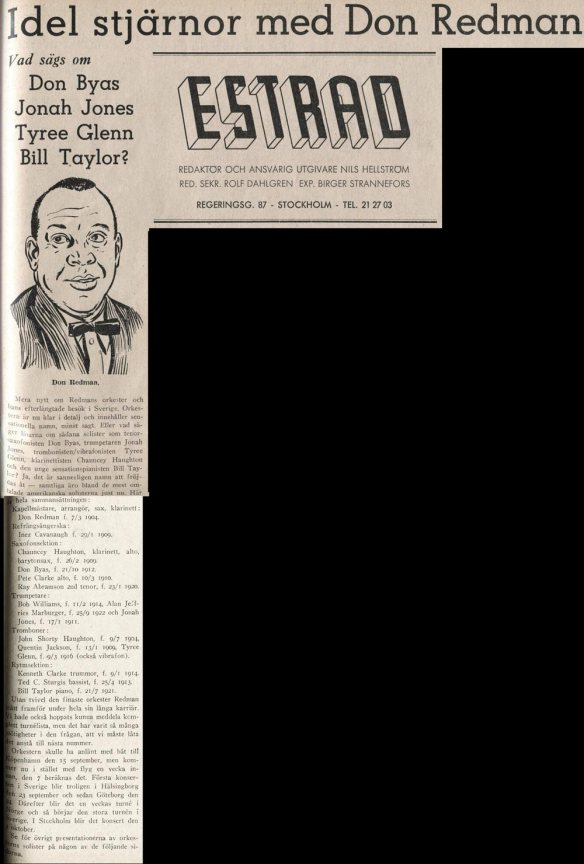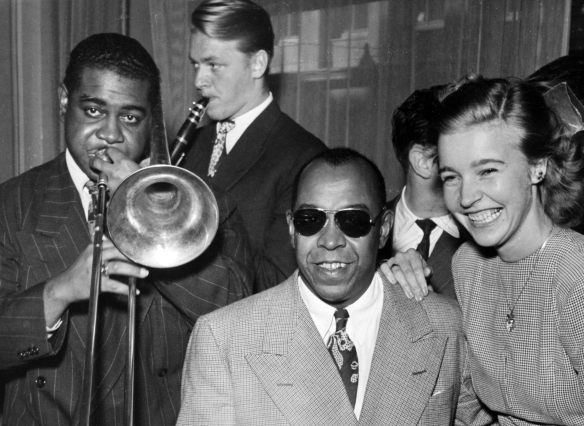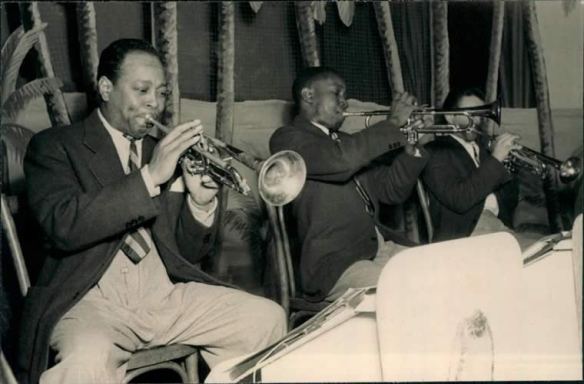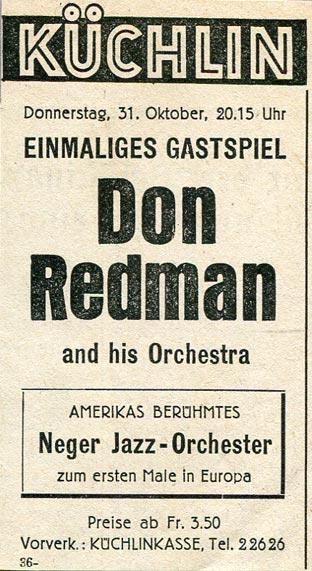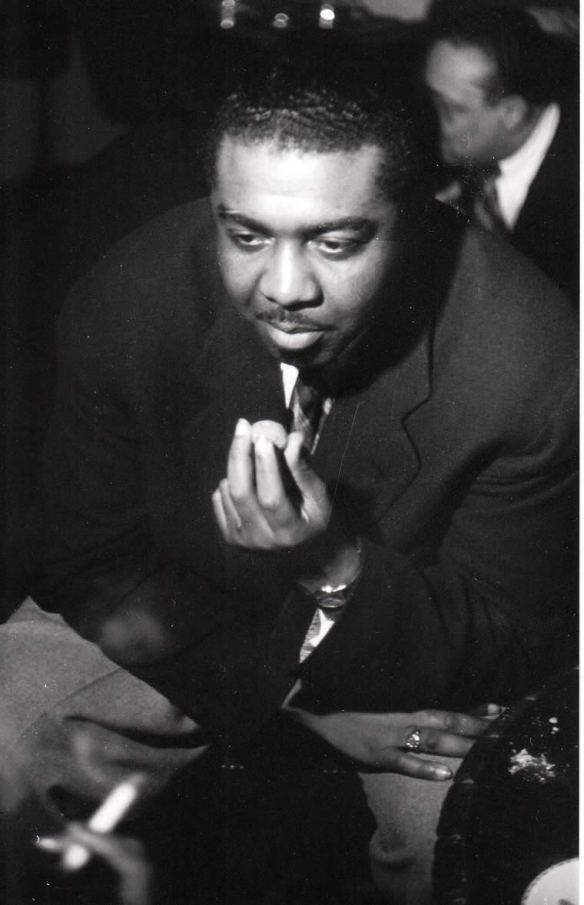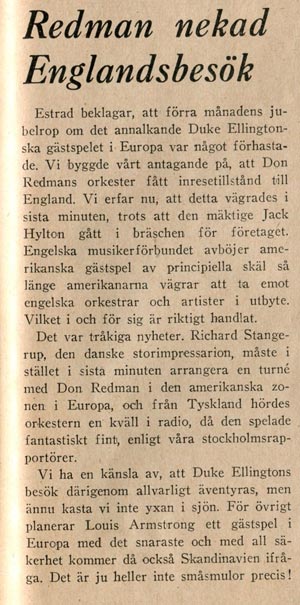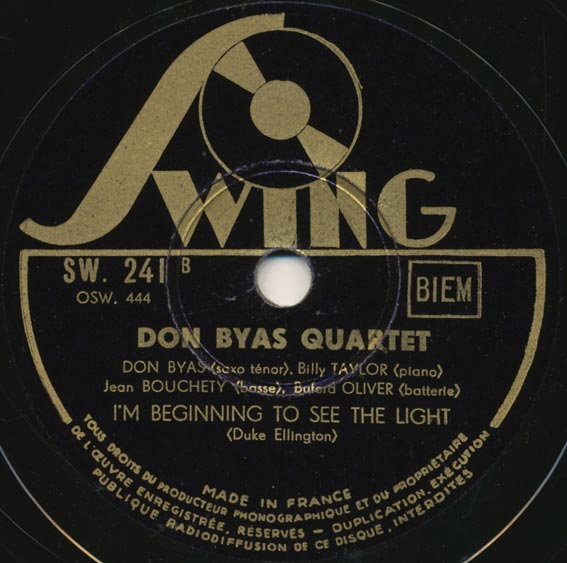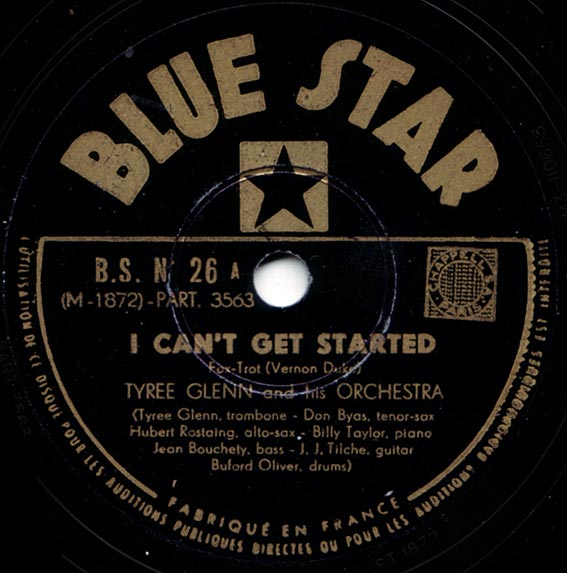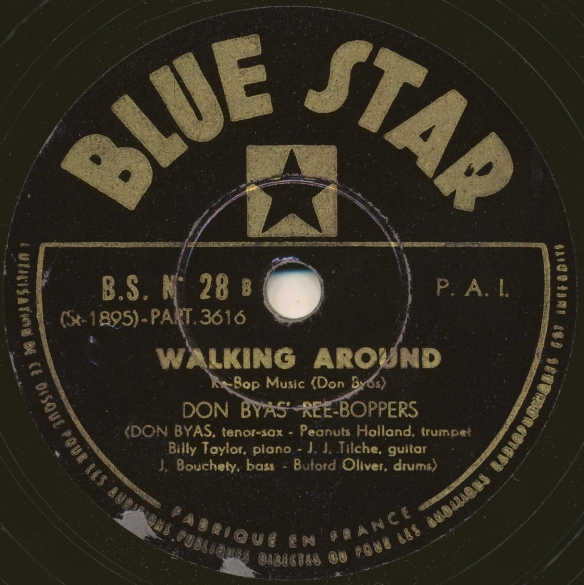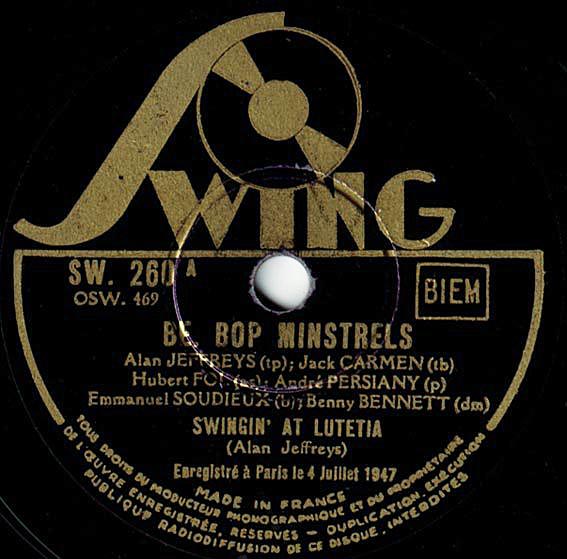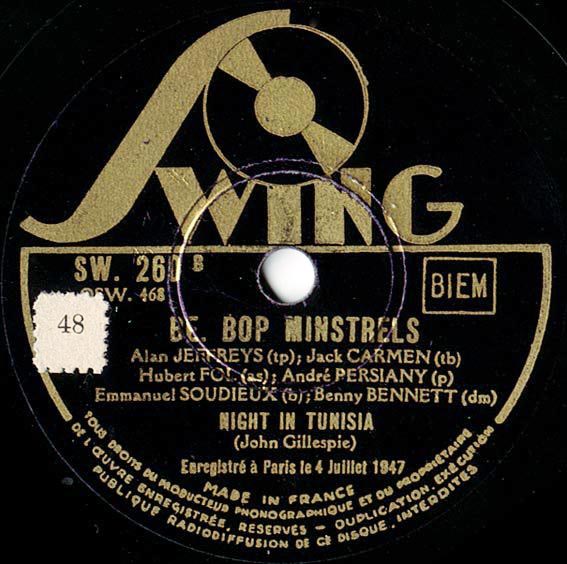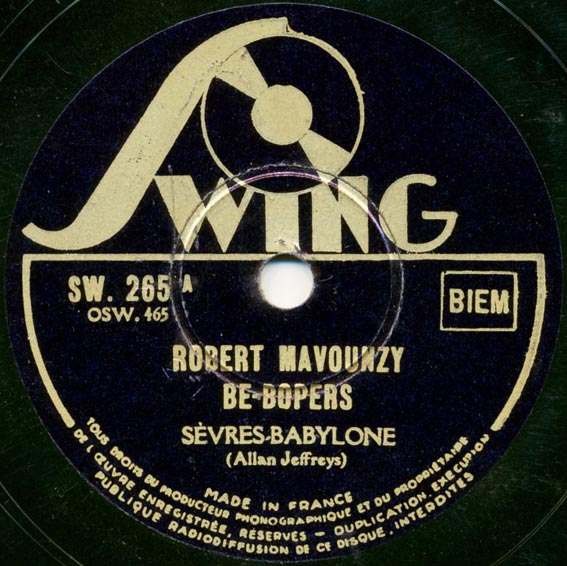Compiled by Armin Büttner, Leif Bo Petersen, Anthony Barnett, Howard Rye, Mario Schneeberger and Dieter Salemann.
Revision notes: (February 23, 2013): Added scan of page 13 from “Expressen”, October 4, 1946, with two articles in relation to the Don Redman tour. Added translation of one of these articles and bits of information from the other.
Special thanks to the Carman family and Patrick Dorian (Distinguished Professor of Music, East Stroudsburg University of Pennsylvania, USA), as well as to Olav Harsløf (Roskilde University, Denmark) and Bent Nielson (Timme Rosenkrantz Collection at the Jazz Collections at the University Library of Southern Denmark). Special Thanks to Peder Hansen and to Little Beat Records (DK) for supplying label scans of rare 78 rpm records. Special thanks also to Pierre Fargeton, Stephan Veil and Georges E. Mathys.
—————————————————————————
A note: Quotes from newspapers and other citations on this website are quoted without editing. They reflect the views and understanding of their respective authors and have to be regarded in the general context of their times. They do not reflect the thoughts of the compilers of this website.
—————————————————————————
DON REDMAN’S 1946 EUROPEAN TOUR
The 1946 European tour of Don Redman’s orchestra looms large in the memory of European jazz fans of a certain generation, as it was the first opportunity after WWII to have a first hand experience of the recent developments in American jazz.
Although besides Jackie Carman and Alan Jeffreys, Redman had almost no genuine be bop musicians in his band, there were a lot of creative spirits involved, that had not missed the revolution that had happened in the US jazz scene. And with For Europeans Only Redman even brought a Tadd Dameron composition along.
Not everybody liked what he heard though at Redman’s European concerts. And people, who did like what they heard, were sometimes thrown out of their own jazz appreciation societies and Hot Clubs, accused of “progressive tendencies”. However a lot of younger jazz musicians were fascinated by the new trends that they heard in embryonic form during these concerts, Soon after they began to form Europe’s first bebop bands.
The initiative to the tour came from the Danish “jazz baron”, Timme Rosenkrantz (1911–1969), who had lived together with journalist and singer Inez Cavanaugh in New York during World War II. Returning to Denmark in 1945 he felt that the jazz scene in the Scandinavian countries needed impulses from America, to show them what had happened in jazz since the war broke out. As he found it impossible to establish a tour with major bands like Duke Ellington’s or Count Basie’s, he contacted Don Redman who had been a close friend for years (O. Harsløf, “For Europeans Only,” in “Festschrift für Walter Baumgartner”. Universität Greifswald (2006).
In Europe Redman let it be known that he had not been a bandleader since 1940, but that he was willing to gather a band for a European tour when Rosenkrantz approached him (G. Montassut, “Redman au Beaulieu,” Jazz Hot, 1946, 2nd series, no. 12, 8). However, this is not quite accurate. Redman had in fact had a touring big band during the war from mid 1943 to mid 1944 (“Don Redman Builds Band…,” Billboard, May 29, 1943, 25. “Advance Bookings,” Billboard, July 15, 1944, 16). Redman also seems to have been on his way back as bandleader in January 1946, where he recorded with a 10-piece pick-up band in New York that already featured Don Byas, but this could off course have been triggered off by Timme Rosenkrantz’ suggestions of a European tour.
Your man in New York: Timme Rosenkrantz looking for commisions.
From Politiken, February 6 1946
An ad in Politiken (February 6, 1946, 10) shows Rosenkrantz asking for business commissions in New York. In this way he was trying to get financial support for a two months trip to USA, which, as he announced in the ad, would start on February 9. As he had no economic and organizational powers to set up an extended Europe tour for an American jazz orchestra, he went into cooperation with the Danish concert impressario Richard Stangerup.
They went in company to New York in order to make contracts, and in the spring Swedish jazz magazines reported that Stangerup recently had returned from New York with contracts for a European tour for Don Redman. The Stuff Smith Trio was supposed to follow later on after the Redman tour, and finally a visit of Red Norvo’s Septet would be arranged in February 1947 (“Don Redman och Stuff Smith Hit,” Orkester Journalen, May 1946, 6. “Stuff Smith och Red Norvo Komma hit i vinter,” Estrad June, 1946, 1).
 Orkester Journalen, May 1946, 6
Orkester Journalen, May 1946, 6
British Melody Maker had an article by Leonard Feather in its July 13 1946 issue, titled “U.S. Jazz Is Europe-bound: Redman, Stuff Smith, Hawkins On Way”, from which we quote (emphasis in original article):
Timme Rosenkrantz is now lining up the Don Redman unit, which will begin with a concert in Copenhagen about September 15, continuing in various towns in Denmark and Sweden, also probably in Norway, Belgium and Holland.
STARS FOR PARIS
The band will consist of six brass, five saxes and three rhythm. Timme hopes to get such stars as Harold Baker, Ted Sturgis, Ray Perry and Kenny Clark (sic!). Redman will also play with the band, despite having been inactive as an instrumentalist since 1939.
Timme may also be instrumental in bringing Stuff Smith to Scandinavia with a trio. The Redman band, meanwhile goes into rehearsal August 1. Inez Cavanaugh, who sang so well on Timme’s Victor records may also be with the unit.
In August a notice in the Danish newspaper Politiken (August 15, 9) tells that Engstrøm & Sødring, Volmer Sørensen, and Richard Stangerup had just founded a concert organization named Concern. In collaboration with the English Forster Agency in London they were planning a row of concerts in Copenhagen, among those a visit of Don Redman’s orchestra. In the August issue of Orkester Journalen we get more details: Stuff Smith and Ray Perry are out of the picture by then; the planned arrival of the Redman orchestra is said to be September 15 in Copenhagen, as possible members of the Redman band Harold Baker, Trummy Young, Kenny Clarke and Inez Cavanaugh are mentioned.
Estrad, a Swedish music magazine, Expressen, a Swedish newspaper, and John Lindgreen from Nöjesfältet are in charge of the Swedish part of the tour (“Redman Kommer i Oktober,” Orkester Journalen, August 1946, 6 and “Expressen och Estrad arrangera Don Redmans svenska turné” Estrad, August 1946 ).
 Orkester Journalen, August 1946, 6
Orkester Journalen, August 1946, 6
The august issue of Estrad featured Don Redman on the cover:
 Article from Estrad, August 1946. Courtesy of Stephan Veil
Article from Estrad, August 1946. Courtesy of Stephan Veil
Bill Coleman in his book “Trumpet Story” (first published 1981 in french) tells that he originally was to join Redman’s orchestra for this tour (quoted here from a version in english published in the UK by Macmillan in 1990 (possibly retranslated from the french language original, note “end” where it probably should be “and”). Thanks to Donald Clark for finding this quote:
The club Charles Delauney had contacted me to play in finally opened in January [1949]. The Edward’s band [?], Don Byas, and I were the main attraction […] I knew him from New York of course and I should have been included in the Don Redman orchestra with which he had come to Europe. Unfortunately, Timme Rosenkrantz, who had organized the tour, couldn’t contact me since I was on the away from the Apple end on the road when the band was formed.
In a 2009 interview with Billy Taylor conducted by Marc Myers of JazzWax.com, Taylor relates how he came to tour with Redman:
What happened was that I had just gotten married. So I wasn’t hanging out as much as I had been before I got married. But then I heard that Don Redman was planning this European tour that Timme Rosenkrantz was producing. Don asked if I’d play piano. I told him I had just gotten married. Guys were still coming home from the service in 1946 so bands were still having difficulty finding and holding onto players. Don needed me, so he told me I could bring my wife Theodora. Don took his wife, and Timme took his. Timme’s wife, Inez Cavanaugh, became the band’s singer.
In the September issue of Orkester Journalen we get updated information of Redman’s band, which is identical with the actual personnel, except that Jonah Jones is mentioned on trumpet, Shorty Haughton (i.e. Chauncey Haughton) on trombone, and Kenny Clarke on drums (“Redmans Band Stjärnspäcket,” Orkester Journalen, September 1946, 6).
The updated information is also found in two articles in the September issue of Estrad:
Article from Estrad, September 1946. Courtesy of Stephan Veil
Article from Estrad, September 1946. Courtesy of Stephan Veil
A short unsigned note in Jazz Hot (No. 9, September-October 1946) tells that Jonah Jones desisted in the last minute and that as of yet no concerts are planned in France.

Small note in Jazz Hot
(No. 9, September–October 1946).
As it turned out the orchestra had to give up sea transportation to Denmark because of a seamen’s strike (see article by Andy Gurwich below). Although September 6 1946 is quoted as date of departure for Tyree Glenn (Drottningholm passenger list, 19 May 1947) and Chauncey Haughton (Drottningholm passenger list, 13 January 1948), the orchestra came by plane already on September 7, using the spare time in Copenhagen for rehearsals, probably in compensation for rehearsals during the planned boat trip to Europe. The plane was delayed and arrived at Copenhagen Airport in Kastrup, Denmark at 19.30 h – four hours too late. A committee of Danish musicians had been waiting to welcome the band (“Den Sorteste Jazz I K.B.-Hallen,” Politiken, September 9, 1946, 4. / H. Nicolausson, “Svart Jazz I Köpenhamn,”Orkester Journalen, October 1946, 10.)
Waiting for the Redman band: On the van (from left): Danish musicians, Leo Mathiesen, Kai Ewans, Tage Rasmussen, Poul Thaulow, Carlo Jensen, Frank Jensen, and John Steffensen. On the ground (from left): concert promotor Sejr Volmer Sørensen, Danish musicians Jimmy Campbell, Kaj Timmermann, Johnny Campbell, and Norwegian drummer Pete Brown.
(Photo by H. Mass in E. Wiedemann. Jazz I Danmark, vol. 2 (1982), 338.)
The arriving orchestra consisted of: Peanuts Holland (tp, voc), Bob Williams, Alan Jeffreys [nèe Marburger](tp), Tyree Glenn (tb & voc), Quentin Jackson (tb, voc), Jackie Carman (tb), Chauncey Haughton (cl, as), Don Byas (ts, arr), Ray Abrams (ts), Ted Sturgis (b, arr), Buford Oliver (dr), Inez Cavanaugh (voc), Don Redman (ldr, voc, as, arr). Pete Clark and Billy Taylor arrived a couple of days later because they had troubles in getting a passport (H. Nicolausson, “Svart Jazz I Köpenhamn,” Orkester Journalen, October 1946, 10).
After the arrival Don Redman immediately had to hurry to the Danish State Radio to take part in a Saturday night entertainment show, Weekend-Hytten.
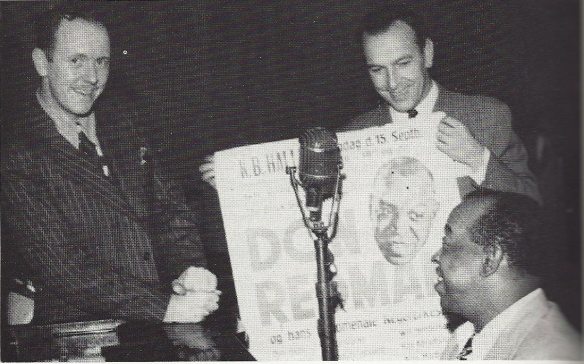 From left: Timme Rosenkrantz, Orchestra leader Bruno Henriksen, and Don Redman in Radiohuset. (Photo by H. Mass in E. Wiedemann. Jazz I Danmark, vol. 1 (1982), 180).
From left: Timme Rosenkrantz, Orchestra leader Bruno Henriksen, and Don Redman in Radiohuset. (Photo by H. Mass in E. Wiedemann. Jazz I Danmark, vol. 1 (1982), 180).
Politiken, September 9, 1946, 4.
Meanwhile Redman’s musicians went to their hotel and afterwards out into the city to seek jamming opportunities, which they found with Leo Mathiesen at Restaurant München and the Campbell brothers as well as the Harlem Kiddies at Restaurant Gold Digger.
During the next week Redman’s crew was rehearsing at daytime, and at night they took part in numerous jam sessions, at restaurants and in private homes. The young Danish jazz pianist Boris Rabinowitch, later on a renowned jazz critic, has told how he and his friends followed the activities:
No, it was later in the night in Klampenborg, at the house of bassist Peter Schiøler when things really started to happen. Among the eagerest ones were two white musicians, trumpeter Alan Jeffreys and trombonist Jackie Carman, and the sound that came out of their horns was, to put it mildly, weird. If Redman had to take a couple of palefaces, why then had he chosen those who couldn’t play? Later it became still more mysterious when it seemed that they were apparently contented to play those odd phrases and figures – at the same time! On the following evening things got cooking in Hvidovre, another suburb of Copenhagen, at drummer Willy Traving’s place. The first one I met when I arrived was my good friend trombonist John Darville, who said “That crazy white trumpeter is here again – and nobody can stop him!” One that night I came to realize that he wasn’t after all that crazy. After a while we started talking and for the first time in my life I heard the word “rebop” and a demonstration of how to sing it. That evening changed my life. And I ‘m sorry to admit that my feelings for the idols of that time like Sidney Bechet and Johnny Hodges would never be the same again.
(Boris Rabinowitch, liner notes to the LP: For Europeans Only. Steeplechase Classics 6020/21 (1983). See also Rabinowitch here: http://www.dr.dk/DR2/1-0/117ting/Underholdning/Redman.htm).
While Boris Rabinowitch is talking about the roles of Alan Jeffreys and Jackie Carman in bringing Bebop to Europe, Billy Taylor in the interesting interview conducted by Marc Myers of blog JazzWax.com emphasizes the importance of Don Byas’ style in this regard.
A small notice from an unidentified Danish newspaper, published in mid September tells us that the renowned Russian conductor Nikolai Malko visited the Redman Orchestra while it was rehearsing at Radiohuset.
 From the Timme Rosenkrantz Collection
From the Timme Rosenkrantz Collection
at the Jazz Collections at the
University Library of Southern Denmark.
This is the translation of the notice above:
Don Redman and Nikolai Malko
Some days ago the famous director, Professor Nikolai Malko, who presently visits Denmark had the opportunity to be present at one of Don Redman’s rehearsals in Radiohuset. His enthusiam was beyond all limits, and to an American journalist he stated that Don Redman is one of the highest gifted artists he had ever met, maybe the greatest musical talent in American music of today.
Moreover there is great probability that Professor Malko will incorporate Redman’s newest symphonic composition, “Frantic Atlantic” (which in the near future will be performed by no less than the Boston Symphonic Orchestra), in his repertoire. This raised his wholehearted enthusiam when last Sunday he was present at one of the Redman concerts.
Harry Nicolausson, editor of Swedish Orkester Journalen, had traveled to Copenhagen to follow Redman’s first week here, and he reported in the October issue:
 From Orkester Journalen, October 1946
From Orkester Journalen, October 1946
On September 8 Redman and his musicians encountered musicians from Peter Rasmussen’s band at the Restaurant Skandia.
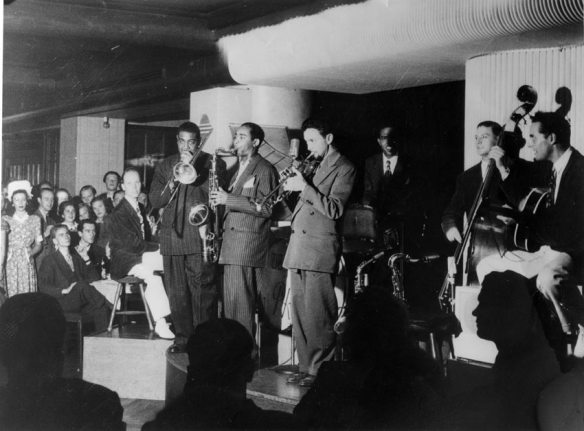 Don Redman’s Orchestra meets Peter Rasmussens’s band at the Restaurant Skandia in Copenhagen, September 8 1946: Börge Nordlund, Tyree Glenn, Don Byas, Alan Jeffreys, Buford Oliver, Christian Jensen, Jörn Grauengaard.
Don Redman’s Orchestra meets Peter Rasmussens’s band at the Restaurant Skandia in Copenhagen, September 8 1946: Börge Nordlund, Tyree Glenn, Don Byas, Alan Jeffreys, Buford Oliver, Christian Jensen, Jörn Grauengaard.
Photo by Helge Mass. From the Otto Flückiger Collection.
 Uffe Baadh (later known as Frank Bode in the USA), Don Byas, and Christian Jensen
Uffe Baadh (later known as Frank Bode in the USA), Don Byas, and Christian Jensen
at the Restaurant Skandia in Copenhagen, September 8 1946.
Photo by Helge Mass, by courtesy of Little Beat Records
On September 9 the Danish State Radio recorded a more formal jam session with Redman’s crew and leading Danish musicians. The session took place at Restaurant München, and a reportage was broadcast on September 12. Billedbladet brought a photo reportage from this event on September 17.

Reportage from the jam session at Restaurant München, Copenhagen, September 9, 1946, with photos by A. E. Andersen. Published in Billed-Bladet, September 17.
———————————————-
Copenhagen Jam Session
Restaurant München, September 9 1946
Peanuts Holland (tp, voc), Don Byas (ts), unknown (ts), Svend Asmussen (vl), Tyree Glenn (tb), Don Redman (p, voc), Leo Mathisen (p), Helge Jacobsen(g), Niels Foss(b), Buford Oliver(dr), unknown (dr).
Gee, Baby! Ain’t It Good to You (DR only)
Blues in F (Billie’s Bounce) (inc.) (unknown tp, TG, unknown ts, LM, HJ, NF, BO
Tea for Two (inc.) (TG, SA, LM, HJ, NF, BO)
Blues (unknown tp, TG, LM, HJ, NF, unknown drummer)
Body and Soul (unknown tp, TG, LM, NF, unknown drummer, probably no HJ)
Confessin’ (PH, LM, NF, unknown drummer)
Laura (DB, LM, NF, unknown drummer)
Sweet Georgia Brown (inc.) (DB, LM, NF, unknown drummer)
These Foolish Things
Lover
Information from Erik Raben’s Danish Jazz Discography at www.jazzdanmark.dk. We have not had access to this broadcast, which still exists in the Archives of DR. Tea for Two was released on Swan Music(D)2510-2(CD), Svend Asmussen Collection, vol. 10. The complete material is in the process of being published by Little Beat Records (Denmark).
————————————————————————————-
Another set of private jam sessions recordings is described in E. Wiedemann. Jazz i Danmark, vol. 2 (1982), 145:
————————————————————————————-
Copenhagen Jam Session
Unidentified location
Peanuts Holland (tp, voc), Don Byas (ts), Ray Abrams (p), Ted Sturgis (b), Buford Oliver (dr). Peanuts Holland sings on Confessin’. Lover is an unaccompanied drum solo.
These Foolish Things
Confessin’
Lover (dr-solo).
We have not yet had access to these material.
————————————————————————————-
On September 12 Don Redman and his musicians were guests at the founding assembly of Hot Club of Denmark. Afterwards there was a jam session.
On September 14 the Don Redman Orchestra recorded some tracks in the studio of Danish State Radio, Copenhagen. These were made for BFN (British Forces Network), the British military radio in Germany (E. Wiedemann, Jazz i Danmark, vol. 1 (1982), 338.)
Studio Recording at Danish State Radio, Copenhagen, September 14 1946.
Peanuts Holland (tp, voc), Bob Williams, Alan Jeffreys (tp), Tyree Glenn (tb, vib, voc), Quentin Jackson, Jackie Carman (tb), Chancey Haughton (cl, as), Pete Clark (as), Don Byas (ts, arr), Ray Abrams (ts), Billy Taylor (p), Ted Sturgis (b), Buford Oliver (dr), Inez Cavanaugh (voc), Don Redman (as, voc, ldr, arr)
I Got Rhythm (DR arr) Everytime I Feel the Spirit (MLW arr, IC voc)
These two tracks – probably the complete music from this broadcast – have survived in the collection of Dieter Salemann, whom we thank for making these rare documents available.
—————————————-
On I Got Rhythm the tenors play five chorusses, Byas two, Abrams two, one is split between them. According to Mario Schneeberger, Abrams is less convincing here than in other versions of this tune. Other soloists are Jacky Carman(tb) and Alan Jeffreys (tp). On Everytime I Feel The Spirit, Ray Abrams plays a fine solo of 16 bars. Of course Inez Cavanaugh sings on this track.
—————————————————-
 Ad from “Politiken”, September 15 1946
Ad from “Politiken”, September 15 1946
On September 15 Redman’s European tour premiered with three concerts at KB-Hallen in Copenhagen. Timme Rosenkrantz recorded most of the first concert on lacquers. Danish Steeplechase commercially released this material in 1983.

The original laquers are in the Timme Rosenkrantz Collection, now in the Jazz collections at the Library of University of Southern Denmark.
Here is a copy of the program for the Copenhagen concerts:
 (Click to enlarge) Page 4 (with an ad for the upcoming danish concerts by Ted Heath)
(Click to enlarge) Page 4 (with an ad for the upcoming danish concerts by Ted Heath)
and page 1 of the program for the Copenhagen concerts. Courtesy of Bent Nielson (Timme Rosenkrantz Collection at the Jazz Collections at the
University Library of Southern Denmark)
The pieces to be played on the Copenhagen concerts are identical to those supposed to be played in switzerland judging from pages 2 and 4 of the Copenhagen program:
 (Click to enlarge) Pages 2 and 3 of the program for the Copenhagen concerts.
(Click to enlarge) Pages 2 and 3 of the program for the Copenhagen concerts.
Courtesy of Bent Nielson (Timme Rosenkrantz Collection at the Jazz Collections at
the University Library of Southern Denmark).
Timme Rosenkrantz had a disc cutting machine running at K.B. Hallen. His recordings were much later issued on Steeplechase SCC 6020/21 (2 LP) and SCD 36020 (CD).
————————————————————————————-
For Europeans Only
KB-Hallen, Copenhagen, September 15 1946. There were three concerts that day: 16 h, 18:45 h and 21h, it is not known which set(s) were recorded.
Peanuts Holland (tp, voc), Bob Williams, Alan Jeffreys (tp), Tyree Glenn (tb, vib, voc), Quentin Jackson, Jackie Carman (tb), Chancey Haughton (cl, as), Pete Clark (as), Don Byas (ts, arr), Ray Abrams (ts), Billy Taylor (p), Ted Sturgis (b), Buford Oliver (dr), Inez Cavanaugh (voc), Don Redman (as, voc, ldr, arr)
Metronome All Out (DR arr)
For Europeans Only (TD arr)
Don’t Blame Me (EH arr)
All the Things You Are (DR arr)
Everytime I Feel the Spirit (MLW arr, IC voc)
Frantic Atlantic (DR arr)
How High the Moon (DB arr)
Laura (DB arr)
I Got Rhythm (DR arr)
Chant of the Weed (DR arr)
Take Off Those Dark Glasses (DR arr & voc)
“Oo-Ba-Ba-Le-Ba” (Anthropology) (?? arr, PH voc)
My Melancholy Baby (EH arr)
Stompin’ at the Savoy (DR arr, PH voc)
The World Is Waiting for the Sunrise (BT arr)
All tracks issued on Steeplechase SCC 6020/21 (2 LP) and SCD 36020 (CD). Although the next to last track is announced by Redman as “Oo-Ba-Ba-Le-Ba”, the orchestra plays “Anthropology” for one chorus before the singing of “Oo-Ba-Ba-Le-Ba” starts. “Anthropology” probably entered Redman’s repertoire via Don Byas who had recorded it in February 1946 with Dizzy Gillespie.
Ad from “Politiken”, September 22 1946
After World War II the first jazz concerts in Denmark by foreign musicians had been by Swedish bands. In April 1946, after visits of the English orchestras of Vic Lewis, Nat Gonella, and Ted Heath, the jazz Danish magazine Jazzinformation wrote: “We want jazz – real Negro jazz!” The reactions on Redman’s Danish concerts show that everybody felt that this was what they had got.
In the audience in KB-Hallen was a young Dan Morgenstern, living in Copenhagen at this time. He remembers: “…I was 16; the proud owner of a few hundred jazz records… and an avid reader of Panassié. I could hardly wait, and when the magic moment came and the band appeared at KB-Hallen, it was even more exiting than I had anticipated. This was the real thing” (Dan Morgenstern, liner notes to the LP: For Europeans Only. Steeplechase Classics 6020/21 (1983), see also Oral History with Dan Morgenstern at smithsonianjazz.org).
In the communist newspaper Land og Folk (September 16) Børge J. C. Møller wrote: “… During the war many here in Scandinavia have been believing that our great jazz orchestras were very up to date, but then comes Don Redman and outdoes everything we are able to accomplish on this side of the pond…”
The conservative paper Berlingske Tidende (September 16, 1946) wrote: “There was wild enthusiasm in KB-Hallen, many encores and flowers. It is seldom that one here in Denmark has the opportunity to meet the genuine jazz music, as only the Negroes are able to perform it. Yesterday one once again got the proof that jazz is the black m an’s property, and that white men only are able to perform in it as guests.”
Also in Politiken (September 16, 1946, 6) Herbert Steinthal (under the pseudonym “Goofy”) wrote an enthusiastic review:
 Review in Politiken September 16, 1946.
Review in Politiken September 16, 1946.
BLACK MASTERS
The Europe Premiere of Don Redman’s Tour in KB-Hallen
A trumpet roar, a roll of drum increasing into a complete drum rhapsody, this was the opening of Don Redman and His Orchestra’ Europe-tour yesterday in KB-Hallen. Three sold out houses cheered “The Little Giant of Rhythm” and his superb musicians. And they indeed were worth a cheer.
Hardly ever have the citizens of Copenhagen listened to an orchestra with such a crowd of outstanding jazz soloists. With their solo performances they made the concert a great experience. The band Redman has gathered for the tour of Europe does not appear as spontaneous as one had expected. This is primarily caused by numbers played in arrangements held in an utmost strict form, not giving very much opportunity for improvisation. Technically seen they are without doubt exemplary, delicious and grandiose, but it cannot be denied that several times they made one think of the abominable notion symphonic jazz. One had not expected this from a classic figure like Don Redman.
However, the playing was extra-ordinary. One has never enjoyed a drum solo like the one Buford Oliver, the eternal chewing gum chewing percussionist, produced in Ellington’s “Metronome All Out.” Or the strongly sensual playing of Don Byas –who may be the finest tenor-saxophonist in the world- in “Laura,” America’s greatest hit success for the moment. Also his amusing tenor sax duel with Ray Abrams in Gershwin’s “I Got Rhythm.” In grand style is also Tyree Glenn’s trombone playing, shining of tenderness and gentleness, the trumpeter “Peanuts” Holland, and the dazzling pianist Billy Taylor. They simply number among the masters of jazz.”
Danish Harald Grut reviewed the Copenhagen concerts in the October issue of Orkester Journalen. He was a traditionalistic oriented critic, who had been skeptic toward Redman’s hastily organized orchestra, but he totally surrendered, even if he did not like a piece like Frantic Atlantic and also resented Alan Jeffreys’ trumpet playing.
Harald Grut, “Redmans Köpenhamns-konserter”, Orkester Journalen, October 1946. (extract)
 Front page of Estrad 10/1946. Courtesy of Stephan Veil.
Front page of Estrad 10/1946. Courtesy of Stephan Veil.
On September 16 the orchestra played at Fyns Forsamlingshus in Odense. It went on to Aarhushallen in Århus (September 17), Håndværkerforeningen in Aalborg (18), an unknown venue in Hjørring (19), Paladshotellet in Esbjerg (20), and Teatret in Svendborg (21). Finally it returned to KB-Hallen in order to play another three concerts on September 22. (E. Wiedemann, Jazz i Danmark, vol 2 (1982), 86).
————————————————————————————
The start of Don Redman’s Tour was noted in Billboard of September 26:
On its way to Norway the orchestra gave two concerts in Hälsingborg, Sweden, on September 23 and two in Göteborg, Sweden, on September 24. In the period between September 26 and Sepetmeber 30 it gave three concerts in Oslo at the movie theaters Colosseum, Saga, and Regnbuen (“Redmans Turnélista”, Orkester Journalen, October 1946, 6. S. Kristiansen, Jazzen etter 1950 – Preludium med nye impulser (2010.) According to Jan Evensmo, History of Jazz Tenor Saxophone, vol. 4 (1999), a short recording has survived from the Oslo concerts.
————————————————————————————-
Oslo Concert
unknown venue, between September 26 and 30 1946
The Don Redman Orchestra (same as before)
Metronome All Out (inc.) (DR arr)
All Information about this recording from Jan Evensmo, History of Jazz Tenor Saxophone, vol. 4.
————————————————————————————-
The band’s Oslo concerts are covered in “Sigarett Stomp” – Jazz in Norway 1940-50, written by Bjørn Stendahl and Johs Bergh.
Here is a “very rough English translation”, of the important parts kindly supplied by Per Husby (Per’s explanatory notes are in brackets):
Of these (visiting orchestras) Don Redman’s band was of course the big gift to the genuine jazz lovers. After a concert by Nat Gonella in February, (Norwegian jazz violinist) Frank Ottersen in (the newspaper) “Friheten” was only half-heartedly happy and asked: Who can supply us with a first-class American band to visit our country?
The answer was (newspaper) “Dagbladet” and the impresario Max Lefko. “An epoch-making event” was one of Dagbladet’s headlines in mid-September. There were regular follow-up bulletins about “Don Redman and his fabulous negro orchestra – the black giant of rhythm”.
The orchestra arrived by bus in Oslo on September 25th, and was taken straight to the Regnbuen restaurant for a meal, radio interviews, and a short demonstration of “real American jazz”.
These were hectic days for Redman and his band. Six concerts advertised in the Colosseum cinema (seating about 1400 people), three extra concerts in the Saga cinema (cap about 1200), plus a “tea dansant” in the Regnbuen restaurant. A total of 10’000-15’000 people must have attended this sensational guest appearance (in a city of about 300’000 at the time). For the opening concert, the newspapers had taken its job seriously and sent specialists to do the job. (the newspaper) Aftenposten sent Nils Jacob Jacobsen (well known Norwegian jazz writer and enthusiast). Dabladet sent two: The expert (band leader) Øivind Bergh and the self-declared non-expert Egil Falck Andersen.
Critics were unanimously excited. Jazz giants Don Byas, Tyree Gleen and Billy Taylor were singled out as the outstanding soloists of the concert. This was Norwegians’ first meeting with musicians coming straight from the American melting pot, where old swing musicians had met with the challenges of bop music. The arrangement Øivind Bergh was most impressed with, was Tadd Dameron’s For Europeans Only. “It gave a signal of something new”, the attentive Bergh wrote, “and it will be interesting to see if future developments will go in this direction.”
Gösta Hammarlund must have been in the audience on September 26, since his sketches of Don Redman and the band were published in the daily newspaper Dagbladet on September 27.

 Sketches by Gösta Hammarlund, published in Dagbladet, September 26, 1946.
Sketches by Gösta Hammarlund, published in Dagbladet, September 26, 1946.
In October the band played in Sweden again, mostly in two different towns on the same day.
The swedish tour dates as given in Estrad Nr. 10/1946.
On its way from Oslo to Stockholm the orchestra gave concerts in Munkfors, Karlskoga, and Örebro. It arrived in Stockholm on October 3 in the afternoon and had lunch, press reception, recording of a couple of numbers for the Swedish Radio, and a small jam session with Swedish musicians at Carlton. After this it went to Uppsala for an evening concert, and from here it went back to Koncerthuset in Stockholm for one more concert same night (information from “Hört och sett kring Estraden” by “Masen” in “Expressen”, October 4, 1946.
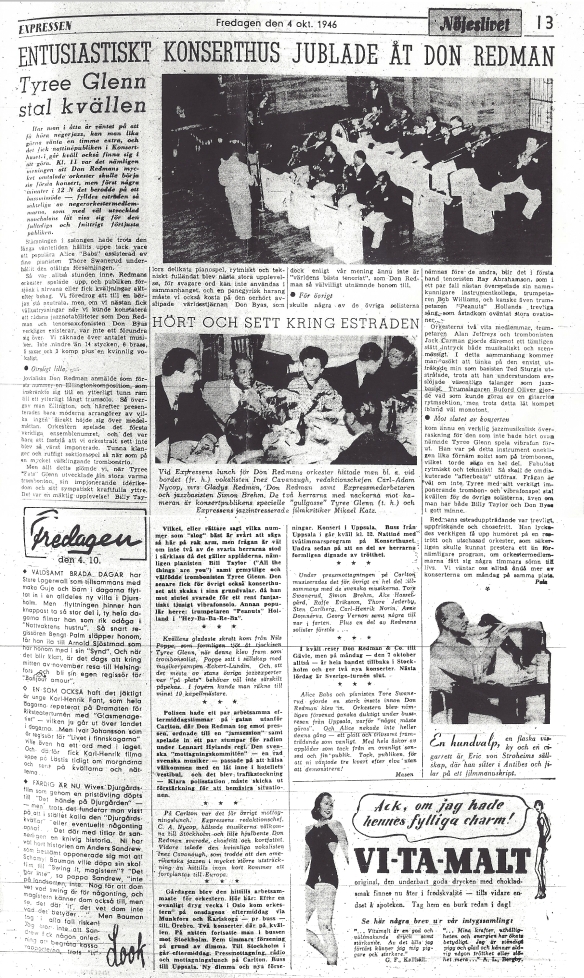 Review by “Pele” of the October 3 concert at Konzerthuset,Stockholm and small
Review by “Pele” of the October 3 concert at Konzerthuset,Stockholm and small
tidbits by “Masen” in “Expressen”, October 4, 1946.
Here is the translation of the Konzerthuset review by “Pele” from “Expressen”, October 4, 1946:
ENTHUSIASTIC KONCERTHUS CHEERED DON REDMAN
Tyree Glenn Stole the Evening
If you’ve waited eight years to listen to Negro jazz, you’re not going to mind waiting an extra hour, and that’s what the late night audience in the Koncerthus yesterday evening had to put up with. It was planned that Don Redman’s widely publicized orchestra would start its first concert at 11 o’clock, but it was not until a few minutes before 12 p.m. – because of bus transport delays – that the stage slowly filled up with the members of the Negro orchestra, who with practiced nonchalance positioned themselves in front of the excitedly delighted capacity audience.
Despite the long wait, the atmosphere in the hall had been sustained thanks to popular Alice “Babs”, who entertained the impatient crowd, assisted by pianist Thore Swanerud.
At last it was time. Redman’s orchestra opened, and the audience attained nirvana or felt nauseous, according to their predeliction. To begin with we preferred to stay neutral, but it was no wonder that we came close to experiencing voluptuous shivers when we realized that jazz notables such as Don Redman and tenor saxophonist Don Byas really exist. We counted the number of musicians. No less than fourteen pieces, six brass, five saxes, three rhythm, and a female vocalist.
• Unbelievably tiny,
jovial Don Redman announced an Ellington-composition as the first number. This was no more than an extremely sparse frame for an extremely long drum solo. That was the last of Ellington, and thereafter only modern arrangers were featured, none of whom immediately stood out from the mediocre. The orchestra played its first real ensemble number and we have to say that from an orchestral viewpoint we were not that impressed: weak sonorities and sloppy ensemble playing, apart from a beautifully harmonious trombone trio.However, we forgot all that when Tyree “Fats” Glenn produced his huge warm trombone-sound, impressively full of ideas, along with a sympathetic and powerful appearance. This was a tremendous experience! Billy Taylor’s delicate piano playing, rhythmically and technically perfect, was the next great experience, because lesser words cannot be used in this context. Fulsome praise should also be paid to the enormously polished international star Don Byas who, however, in our opinion, is not the “world’s best tenor player” as Don Redman so generously dubbed him.
• Of the rest
if any other soloists should be singled out for mention, first would be Ray Abrahamson, who on a couple of occasions came close to surpassing his more famous fellow instrumentalist, trumpeter Bob Williams, and perhaps also even trumpeter “Peanuts” Holland’s genial vocal, which attracted unexpectedly large applause.On the other hand, the two white members of the orchestra, trumpeter Alan Jeffreys, and trombone player Jack Carman, made a rather poor impression, musically as well as presentationally. In this connection one easily recalls the stubbornly bored facial expression radiating from bassist Ted Sturgis, though at times he revealed substantial talents as a jazz bassist. Drummer Buford Oliver did what could be done in a rhythm section without a guitar. Even so the accompaniment sometimes sounded rather monotonous.
• Towards the end of the concert
came one more genuine jazz musical surprise for those who had not previously heard the aforementioned Tyree Glenn playing the vibraphone. On this instrument he was unquestionably just as excellent a soloist as on the trombone, which is saying a lot. Fabulous rhythmically and technically! This is how the much debated “after beats” should be executed. One wonders whether it was not Tyree, with his truly impressive trombone and vibraphone playing, who stole the evening from the other soloists, even if both Billy Taylor and Don Byas stick in the mind.Redman’s bandstand manner was charming, refreshing, and natural. He succeeded in lifting the spirits of a travel-weary and exhausted orchestra, which would probably have been able to deliver a much better program if its members had had the opportunity to catch a few hours sleep. So we expect even more from the concerts next Monday at the same location.
Pele(translated by Leif Bo Petersen with help from Anthony Barnett and Howard Rye)
On October 7 the orchestra was back in Stockholm, playing at Konserthuset and the cinema-theatre Rigoletto.
In the December 9 issue of Life, there is a long report from Sweden written by Wilfrid Fleisher in which he also mentions Don Redman’s success at the Konserthuset:
… And everyone is dancing to American jazz and swing – the hit parade of last year in the U.S. if not of this year. American Negroes are having an astounding success. Tickets for concerts by Don Redman and his band, from New York’s Harlem, were sold out in Stockholm two weeks in advance. The sedate Konserthuset (Stockholm’s concert hall) bills jazz programs between evenings of classical music …
After the concerts in Stockholm there was a jam session at an unidentified venue. A lot of Swedish jazz musicians participated, among them Roffe, Ericsson Arne Domnerus, Åke “Stan” Hasselgard, and Alice Babs, who all later on became internationally known jazz artists (“Svart-vit Jamsession,” Orkester Journalen, November 1946, 30).
 Reader’s letter describing the jam session on October 7 in Orkester Journalen 11/1946. Courtesy of Stephan Veil
Reader’s letter describing the jam session on October 7 in Orkester Journalen 11/1946. Courtesy of Stephan Veil
Here is the translation, supplied by Leif Bo Petersen
Black-white jam session.
Before, in the intermission, and after Don Redman’s two concerts on the evening of October 7 it was generally discussed where the jam session, which inevitable had to follow, should find place. The whole matter was buried in the deepest secrecy, and one had to possess a certain amount of luck in order to join listening.
I was lucky. In fact admission to this exclusive event was not granted anybody without certain resources, partly pecuniary and partly fluid.
As my connection with jazz music so far only had been on the discophile level, I looked forward to a real experience. And indeed, it was marvelous ingredients, which were revealed.
To my great surprise I still found myself on the premises, after the venue had been effectively cleaned from unauthorized elements, a detail that was perfectly taken care of by the watchdog and bassist, Simon Brehm, who unofficially had the duty of first cupbearer.
Now the jam session broke out. Let us have a look on the notabilities: Billy Taylor, Tyree Glenn, Buford Oliver, Ray Abramson from Don Redman’s orchestra, and so, off course, Simon Brehm, Roffe Ericson, Rowland Greenberg, Arne Domnerus, Åke Hasselgård, Bertil Frylmark, and a row of others of our own. Later on the world star Don Byas came floating in magnificent but rocky one-man procession.
Without doubt one listened to much good music. Things that one will remember for a long time, like Billy Taylor’s unbelievable rhythmic unison piano playing and singing. Arne Domnerus, the best sax soloist of the night, Simon Brehm, Bertil Frylmark, Åke Hasselgård. Rowland Greenberg’s Roy Eldridge-trumpet, Tyree Glenn with his preaching, but in the long run boring solos, the most eager soloist of the night.
I previously mentioned something of ingredients. Yes, what should be said about the uncrowned Swedish Swing-queen, who asked Billy Taylor to play “Ain’t Misbehavin” in “Ass Minor” (!) and who with cheerful shouting like “Bounce it, brother!” (pronounced like it is spelled) gave this jam session as distinctive character. Or the Seymourish [e.g. behaving like the Swedish orchestra leader Seymour Österwall] trombone-king’s quick “four bars, four bars, Billy” in a tone, which defies any phonetic description. Could we ask for a change of needle in the Linguaphone-lesson? One of our Swedish tenor stars blew himself into in a self-produced ecstasy to the extent that he had trouble finding the mouthpiece. The statement of the night came from Redman’s vocalist Inez Cavanaugh: “Bessie Smith in her days, wasn’t so great as the great Alice Babs.”
No less.
Florence.
Lars Westin has informed us that the pseudonym “Florence” covers Carl-Erik Lindgreen, who gained access to the jam through his friend Ake Hasselgård. In the 1950s Lindgreen became one of the leading Swedish jazz critics.
Jam session in Stockholm at Restaurant Carlton at Kungsgatan 57, Stockholm,
on October 7: Tyree Gleen, Ake Stan Hasselgård, Don Redman, Alice Babs. Photographer unknown. From Lars Westin ‘s collection
Reviews of the Swedish part of the tour were far more mixed, than the Danish ones.
Swedish dance musician Gunnar Elgeskov reviewed one of the Göteborg concerts in Orkester Journalen (November) and concluded: “I think we should be careful not to fall in trance over a band just because it happens to show the American banner and also is a little dark-skinned. A gathering of excellent soloists and a well-written repertoire is one matter. An orchestra in the proper sense of the word and with color and strong personality is something else…”
G. Elgeskov, “Don Redman I Göteborg,” Orkester Journalen, November 1946).
The Stockholm concerts were also reviewed in the November issue of Orkester Journalen by Julius Jacobsen, introduced as a Don Redman expert, as well as by Harry Nicolausson, editor of the magazine. The former attended both concerts on October 7 and reports that he was disappointed after the first concert, which he characterized as a scrape-together of second-rate musicians with 4–5 absolute top soloists. He was happier after the second concert, and concluded: “it is always amusing to listen to a Negro orchestra, because there is something inexplicable about it, in rhythm as well as in mood…”
Nicolausson also had reservations. He felt that “…Redman had not succeeded in giving it [the orchestra] a personal stamp, what foremost was caused by the weak arrangements…” Nicolausson recognized the skills of the soloists, but accused them of empty audience-pleasing grandstanding and lack of personality.
“Redman en Besvikelse,” Orkester Journalen, November1946, 10 (excerpt).
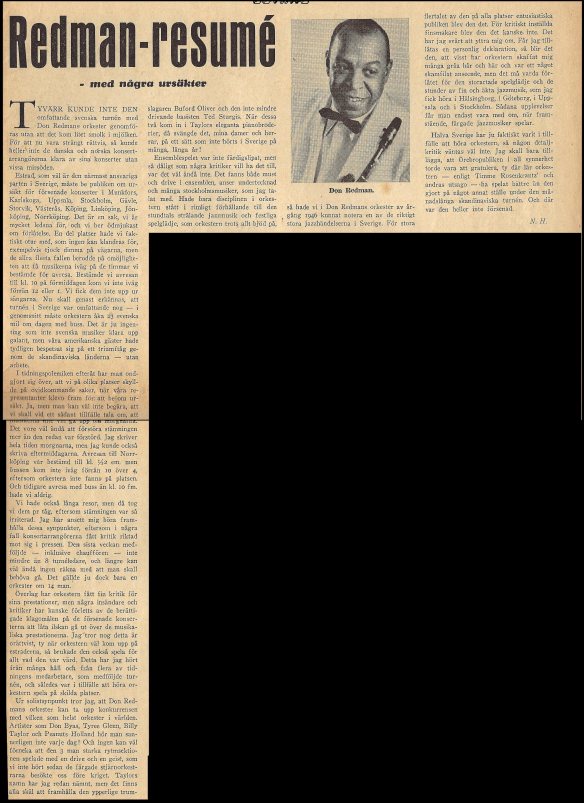
“Redman-resumé” Estrad, November 1946 (excerpt).
In a longer article in the November issue of Estrad editor Nils Hällström, who had been responsible for the Swedish part of the tour, made a kind of status report (see above). For the Swedish public he apologized for a lot delayed concerts, which were partly explained as caused by transportation problems; but he also stated that the musicisians had a responsibility for these: there had been difficulties getting them ready for the next transportation especially in the morning. He concluded:
The orchestra has all in all had a positive reception of its performances (…) when the orchestra finally entered the stages it played with all it had (…) From a solistic point of view I think that Don Redman’s orchestra is able to compete with any band in the world. Artists like Don Byas, Tyree Glenn, Billy Taylor, and Peanuts Holland cannot be heard every day! And no one can deny that the 3 man strong rhythm section played with a drive and a conviction, which we have not heard since the colored star orhestras visited us before the war (…) The ensemble performances did not possess the last finish, but they were not as bad as some critics claim. Both I and many Stockholm musicians find that there was both will and drive in the ensemble parts. If only the discipline in the band had been in line with the somtimes brilliant jazz music and festive performing enthusiasm, which the orchestra showed, then we shouldhave been able to call Don Redmans’s orchestra anno 1946 one of the really great jazz occurences in Sweden.
In an editorial article Hällström elaborated his points of view concerning the attitudes he had meet having ”14 negro- musicians” touring:
”I hope never more to have to be confronted with so much grumbling, scolding, and lacking willl to work, which characterized about half of the members of this band. The bus was not comfortable, the food was not good, the hotels were bad, the travels too long, two concerts per day and three on Sundays were too much. To have to lunch all at the same time, when the bus was passing a bigger town and it was lunchtime was critized. The one half had the lunch and the other half got hungry after about one hour’s drive, where we were out on the road without any chance to get food. Then there were anger and threats.” Hällström compares this with his experiences with Swedish musicians’ positive and helpful attitudes during touring conditions, and closes the article: ”Now, I will not do unjustice to the Redman crew. Most of them were comfortable and nice boys, but a couple of them were troublemakers, which after the festive reception in Copenhagen had got their perspectives twisted. In a way I understand them, and like Timme Rosenkrantz, I will say that you cannot expect that they instantly should be first-rate beings, when they have grown up under seventh-rate conditions. But they could play, they could!”
At this point a note is necessary: Some reactions to the Redman band reveal outdated attitudes towards African-Americans. Nils Hällström’s comments on the problems of touring with the band reflect a very paternalist attitude, which was no doubt transparently obvious to the musicians, who will have interpreted it as racist on the basis of their experiences in the U.S.A., even if in fact it was merely fussy. It is likely that the younger musicians (one suspects) reacted by being as awkward and uncooperative as they could. The situation he describes may well have no more complex origins than this. It seems likely that Timme Rosencrantz, whose African-American partner Inez Cavanaugh was on the tour, was trying to point this out and provide an explanation in a manner gentle enough to avoid further conflict. It is likely that both the musicians’ behaviour and Hällström’s reaction were conditioned by aspects of their upbringing and experience which were not shared.
In Stockholm Buford Oliver is still reported in the band, but in the last part of the Scandinavian tour he broke a leg and had to be hospitalized in Copenhagen. According to what was told at the arrival in Belgium this happened because he had fallen from a stage (A. Gurwitch, “Jazz Returns to Europe,” Metronome, February 1946, 27). In Paris, in December, 1946, Inez Cavanaugh told a slightly different story: In Sweden he had fallen two floors down from a window, which he in drunkenness had mistaken for a door (B. Vian, “Pour la première fois depuis la guerre, un orchestre noir americain va jouer a Paris,“ Combat, December 5, 1946. Reprinted in C. Bourgois (ed.) Boris Vian –Ecrit sur le jazz vol. 2 (1982).
From a notice in Politiken, October 16, 1946, we know that the band ended the Scandinavian part of the tour with a variety engagement at Hollænderbyen in Copenhagen from October 16–18. There was also an ad in the issue of October 17.

Ad from “Politiken”, October 17 1946
BELGIUM
On October 21 the band arrived directly from Copenhagen in Brussels. According to the Journal de Genève (27 September 1946, p.5), the band was originally expected to arrive at Cointrin Airport near Geneva from Scandinavia on 20 October 1946 ( a news item, which is interesting in so far as it indicates that the Belgian visit was inserted after the initial planning. In Brussels writer Andy Gurwitch met the band and decided to follow them along for a while (it is not entirely clear if he was with the tour to its end) and write an article about the happenings for Metronome.
(Click to enlarge) Andy Gurwitch covering the tour for Metronome, February 1947 as reprinted in Jerry’s Rhythm Rag at an unknown date. From the Otto Flückiger Collection
During the stay in Belgium, which was managed by a Belgian movie company, Jack Tunis substituted for Buford Oliver, who had broken his leg in Copenhagen (A. Gurwitch, “Jazz Returns to Europe,” Metronome, February 1946, 26-27). Buford Oliver rejoined the band in Switzerland, but had to play without bass drum, because his right foot was in plaster (“Redman Ej till England,” Orkester Journalen, December 1946, 8). In Belgium the band played at the Royal Theeater in Namur, on October 22.They gave concerts in Antwerp for two consecutive days and then played in Brussels on October 26. Carlos de Radzitzky, Rédacteur en chef of “Hot Club Magazine”, the official magazine of the Hot Club de Belgique was at the concert and wrote a review for the December 1946 issue.
 (Click to enlarge) Review of the Brussels concert by Carlos de Radzitzky in “Hot Club Magazine” (belgium) No. 12/1946 from the collection of Otto Flückiger. The photo on the lower right was taken at a press conference organised by the Hot Club de Belgique at “Cado-Radio”, a phonograph shop also selling records. It shows Willy de Cort, Edit-Administr. of Hot Club Magazine, Carlos de Radzitzky, Don Redman, Albert Bettonville, Secrétaire général of Hot Club Magazine and Don Byas.
(Click to enlarge) Review of the Brussels concert by Carlos de Radzitzky in “Hot Club Magazine” (belgium) No. 12/1946 from the collection of Otto Flückiger. The photo on the lower right was taken at a press conference organised by the Hot Club de Belgique at “Cado-Radio”, a phonograph shop also selling records. It shows Willy de Cort, Edit-Administr. of Hot Club Magazine, Carlos de Radzitzky, Don Redman, Albert Bettonville, Secrétaire général of Hot Club Magazine and Don Byas.
For the cover of this issue the HCM staff decided to use a photo of Redman’s orchestra from a 1934 movie. And they even put a small Don Redman poster on the next to last page.
Cover of “Hot Club Magazine” (belgium) No. 12/1946 from the Otto Flückiger Collection
 “Cut along the dotted line”: Page 17 of belgian “Hot Club Magazine” No. 12/1946.
“Cut along the dotted line”: Page 17 of belgian “Hot Club Magazine” No. 12/1946.
From the Otto Flückiger Collection
.
On the back of the booklet to the CD Chrono(lo)gical Classics CD 1009 Don Byas 1946 there is a photo of parts of the Don Redman Orchestra in Brussels ( with belgian drummer Jackie Tunis instead of Buford Oliver) from the collection of belgian collector Léon Dierckx. The photo is dated October 6, 1946 on the Cd sleeve, but at that time the orchestra was still somewhere in Sweden. So it was probably taken on October 26.
 The Don Redman Orchestra in Brussels,photo from the collection of Léon Dierckx. The photo was used for the booklet of Chrono(lo)gical Classics CD 1009, Don Byas 1946.
The Don Redman Orchestra in Brussels,photo from the collection of Léon Dierckx. The photo was used for the booklet of Chrono(lo)gical Classics CD 1009, Don Byas 1946.
 Another shot from the same series. From the Timme Rosenkrantz Collection, the Jazz collections at the Library of University of Southern Denmark
Another shot from the same series. From the Timme Rosenkrantz Collection, the Jazz collections at the Library of University of Southern Denmark
 Don Byas, probably in Belgium, photographer unidentified.
Don Byas, probably in Belgium, photographer unidentified.
From the Otto Flückiger Collection.
 Don Redman and Ted Sturgis at an unidentified location (probably a studio). Photographer unidentified. From the Timme Rosenkrantz Collection, the Jazz collections at the Library of University of Southern Denmark.
Don Redman and Ted Sturgis at an unidentified location (probably a studio). Photographer unidentified. From the Timme Rosenkrantz Collection, the Jazz collections at the Library of University of Southern Denmark.
In a 2011 conversation with Mario Schneeberger, John Ward (born in 1927, real name Jan Baptiste Verwoerst), the former drummer with Hazy Osterwald, remembered that he jammed with Redman’s musicians (Ward especially remembers Don Byas) at the “Boeuf sur le toit” at Porte de Namur in Brussels.
SWITZERLAND
 Flyer for the swiss part of the tour.
Flyer for the swiss part of the tour.
From Hans Philippi’s notebooks in the collection of Mario Schneeberger
From Brussels the band went by train to Geneva where they played at Victoria Hall on October 27 and 28. In a short preview article, “Notes sur les musiciens de l’orchestre Don Redman” in swiss “Hot-Revue” No. 11 1946, Kurt Mohr (as K.M.) had written what he knew about the careers of the members of the band to play in switzerland soon.
 Article by Kurt Mohr in “Hot-Revue” No. 11 1946.
Article by Kurt Mohr in “Hot-Revue” No. 11 1946.
From the Otto Flückiger Collection
The article ends with:
Beauford Oliver (dms), Alen Marburger et John Carman (trp. et guit.). Aucun renseignements sur ces musiciens”
The last sentence translates “no information about these musicians”. Notice though, that Mohr wrongly presumed that Carman/Carmen was a guitarist. Also note that Alan Jeffreys is given here with his real family name, Marburger. It seems clear that it was transmitted in this way to the european promoters.
 Ad for Geneva concert, unidentified newspaper, October 27, 1946.
Ad for Geneva concert, unidentified newspaper, October 27, 1946.
From the Otto Flückiger Collection
The concert on the October 27 (which consisted of two or more sets) was recorded by Swiss Radio.
————————————————————————————-
Geneva Concert
Victoria Hall, Geneva, October 27, 1946
The Don Redman Orchestra (same as before, Quentin Jackson also voc.)
Metronome All Out (DR arr)
Stardust (?? Arr, QJ voc)
For Europeans Only (TD arr)
All the Things You Are (DR arr)
Alexander’s Ragtime Band* (BT, TS, BO only)
Everytime I Feel the Spirit (MLW arr, IC voc)
My Melancholy Baby* (EH arr)
Limehouse Blues*
Laura* (DB arr)
How High the Moon* (DB arr)
Carrie Mae Blues* (DR? arr, PH voc)
I Got Rhythm* (DR arr)
Good House (TS arr)
Stormy Weather*
Tea For Two*
Oo-Ba-Ba-Le-Ba (Anthropology) part I
Oo-Ba-Ba-Le-Ba (Anthropology) part II
Embraceable You
Unidentified Swing Riff Tune
These Foolish Things*
Stompin’ at the Savoy* (DR arr, PH voc)
All tracks are on a 2 CD set of private and/or broadcast recordings (it seems the original source for the Geneva concert on this 2 Cd set was a tape) from the Otto Flückiger collection. The concert consisted of two sets. Set one ran from Metronome All Out to I Got Rhythm, the second set from Good House (Good Hours) to Stomping At The Savoy (and possibly even longer). Selections marked * are on the CD Swiss Radio Days Volume 11: Don Redman Orchestra Geneva 1946, TCB CD 2112. The tracks on the TCB CD come from the archives of Swiss Radio DRS. The liner notes say that all tracks on TCB CD 2112 were recorded on October 27.

The announcement for the unidentified Swing Riff Tune (a close relative of “Christopher Columbus”) is lost. Track 6 is called Perdido on the source CD, but well, it is not Perdido after all. From Anthony Barnett and Leif Bo Petersen we know that “Good House” (Mario Schneeberger and Armin Büttner still tend to think it is “Good Hours”) is a version of “Wahoo”. This line based on Perdido was composed by bass player Ted Sturgis. There is another version of this tune recorded in Basel (see below). In Geneva this track was announced by Don Redman as Sturgis’ composition – and arrangement – called “Good House” (or “Good Hours”, according to Schneeberger and Büttner). Sturgis also has a long bass solo on this track. For Anthony Barnett’s and Leif Bo Petersen’s detailed history of the “Wahoo” line on Perdido and its authorship, go here.
The next to last track was announced by Redman in Copenhagen as “Oo-Ba-Ba-Le-Ba”, but the orchestra plays “Anthropology” before the singing starts.
 Ad for the program of Radio Sottens.
Ad for the program of Radio Sottens.
From Hans Philippi’s notebooks in the collection of Mario Schneeberger
Parts of the Geneva concerts were broadcast through Radio Sottens on Oct. 28 1946. And parts of these broadcasts survived in the hands of collectors. For a long time these tracks:
– I Got Rhythm
– Oo-Ba-Ba-Le-Ba (Anthropology) (?? arr, PH voc Part 2, incomplete, radio speaker voiceover
– Tea For Two, incomplete, radio speaker voiceover
were thought to stem from the Lausanne concert on Oct. 29. Comparing them with the Geneva recordings Mario Schneeberger noticed they are identical – apart from the voice-over by the announcer. The definitive proof that these three tracks are from Geneva comes in I Got Rhythm, where the badly executed quote from Red Cross in Ray Abrams’ solo is identical.
———————————————————————————–
According to an e-mail conversation with Georges Mathys (born 1918, known on the swiss jazz scene as organizer of the Jazz in Yverdon concert series), Mathys witnessed the concerts in Geneva and Zürich. He met the band and had the opportunity to ask them for their autographs.
 (Click to enlarge)
(Click to enlarge)
A double page from Georges Mathys’ scrap book.
From the collection of Georges E. Mathys
 Peanuts Holland in Geneva, photo by Freddy Bertrand.
Peanuts Holland in Geneva, photo by Freddy Bertrand.
(courtesy of www.jazzorama.ch)
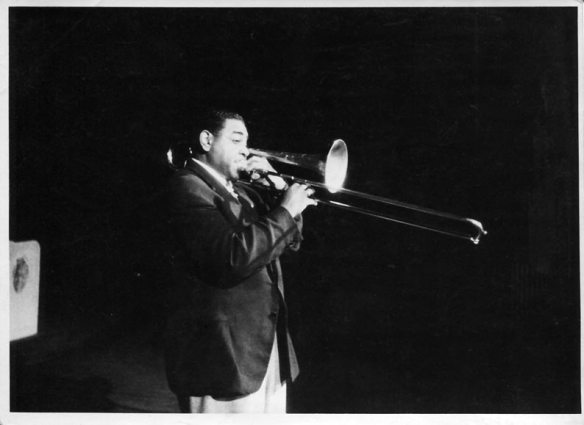 Tyree Glenn in Geneva, Switzerland, photo probably by Freddy Bertrand.
Tyree Glenn in Geneva, Switzerland, photo probably by Freddy Bertrand.
From the Otto Flückiger Collection
 Peanuts Holland and Ted Sturgis in Geneva, photo by Freddy Bertrand.
Peanuts Holland and Ted Sturgis in Geneva, photo by Freddy Bertrand.
(courtesy of www.jazzorama.ch)
 Billy Taylor in Geneva, photo by Nations, Genève (courtesy of www.jazzorama.ch).
Billy Taylor in Geneva, photo by Nations, Genève (courtesy of www.jazzorama.ch).
Buford Oliver in Geneva, unidentified location. Photo probably by Nations, Genève.
From Hans Philippi’s notebooks now in the collection of Mario Schneeberger
 Don Byas, Ray Abrams and Ted Sturgis in Geneva, photo by Freddy Bertrand.
Don Byas, Ray Abrams and Ted Sturgis in Geneva, photo by Freddy Bertrand.
(courtesy of www.jazzorama.ch)
After the concert on October 28, Redman’s band went to the Palais d’Hiver where they met swiss bandleader Jerry Thomas and his Swingtette for a jam session. Jerry Thomas was very popular all around Lake Geneva. The second sax man from the left on the photo below (holding an alto) is Glyn Paque, who was a member of Jerry Thomas’ band at that time. Paque, born in Poplar Bluff Missourin in 1906 had worked with Jelly Roll Morton, King Oliver, Luis Russell, Benny Carter and Willie Bryant in the USA before he went to Europe with Bobby Martin’s orchestra in 1937. Paque stayed in Switzerland until his passing in August 1953.
The Don Redman Orchestra meets the Jerry Thomas Swingtett, at the Palais d’Hiver in Geneva, photographer unidentified. From the Otto Flückiger Collection.
According to Kurt Mohr’s article in Hot-Revue No. 12/1946, peanuts Holland told him that the band was “on the edge” at concerts, “no wrong note is allowed!”. Mohr writes that Quentin Jackson played bass at the Palais d’Hiver jam session.
Another photo from the Palais d’Hiver with members of the Redman orchestra was found in Hans Philippi’s notebooks.
 Jamming at the Palais d’Hiver in Geneva: Tyree Glenn, Billy Taylor, Chauncey Haughton, Peanuts Holland, Buford Oliver, Don Byas. Photographer unknown.
Jamming at the Palais d’Hiver in Geneva: Tyree Glenn, Billy Taylor, Chauncey Haughton, Peanuts Holland, Buford Oliver, Don Byas. Photographer unknown.
From Hans Philippi’s notebooks in the collection of Mario Schneeberger
Among the people who signed the original photo above is swiss clarinet and saxophone player Loys Choquart. Choquart can be seen with Quentin Jackson and Pete Clarke in another photo, probably also taken in Geneva:
Exactly the other way around: Pete Clarke, swiss bandleader Loys Choquart and Quentin Jackson, probably in front of Cornavin train station, Geneva, probably October 28 1946. Clip from an unidentified (french language) publication.
From the Otto Flückiger collection.
On October 29, the orchestra played in Lausanne at the Théâtre Municipal (the concert began at 20.30 h). It was thought that some recordings survived from the Lausanne concert, but these stem from the Geneva concert (see above) The evening was reviewed on page 8 of the Gazette de Lausanne, 2 November 1946.
 Concert review in
Concert review in
Gazette de Lausanne, Nov 2, 1946.
————————————————————————————-
In the german speaking part of switzerland the concerts were eagerly anticipated

Preview article in Schweizer Filmzeitung. The author with the pseudonym “Pic-up” obviously is trying to justify his writing about an upcoming jazz concert here by mentioning some (unnamed) short movies Redman made.
From Hans Phillippi’s notebooks in the collection of Mario Schneeberger
Don Redman comes to Switzerland! Truly an event for all of the swiss jazz world, for is this not the first good foreign orchestra that we get to hear since the war? One could even argue that it possibly is the best orchestra that ever played on swiss ground. Louis Armstrong came here with a just average orchestra and Coleman Hakins played with swiss ensembles. But we are are wise enough to judge only after we heard the band.
In short, the career of Redman – the little giant of swing – went like this:
Born in July 1900. He was a child prodigy playing no less than four instruments. When he was 23 he he was engaged as alto saxophonist and arranger by Fletcher Henderson. At that time he wrote the most beautiful arrangements like I’m coming Virginia or Hot Mustar and others. At the age of 26 he took over McKinney’s Cotten (sic!) Pickers, and five years later he led his own band. In 1941 he left leading a band behind to concentrate on arranging – a thing he is able to do better than playing an instrument. But he never received the laurels he deserved, that is why we wish him a lot of success for his comeback on the continent. He did some short movies – of which unfortunately I know only one – but this one is of considerable quality. His current orchstestra partly consists of good and experienced musicians like for example Pete Clark (alto), Quentin Jackson (trombone), “Peanuts” Holland (trombone (sic!)), Tyree Glenn (vibraphone, trombone) and especially tenor saxophonist Don Byas. In 1939 he was a member of the Andy Kirk Orchestra and since 1942 he was with the incomparable Count Basie. Today Byas counts among the best tenorists in the world. He is showing an unbelievable musicality, though often expressing it with totally modernistic ideas. Possibly the dyed-in-the-wool fans of Hot will not like him too much, but the more open jazz fans will do so even more. Unfortunately in Switzerland from the great series of Basie recordings only Royal Garden Blues is available. But Byas knows how to fill us with enthusiams with only just this record.
Surely at these few concerts the whole swiss jazz world will gather to hear this promising orchestra. Pic-up
 Page 1 of the program for the german speaking parts of Switzerland. This photograph was taken by A. E. Sørensen at the jam session in Restaurant München, Copenhagen, September 9, 1946. From the Otto Flückiger Collection
Page 1 of the program for the german speaking parts of Switzerland. This photograph was taken by A. E. Sørensen at the jam session in Restaurant München, Copenhagen, September 9, 1946. From the Otto Flückiger Collection
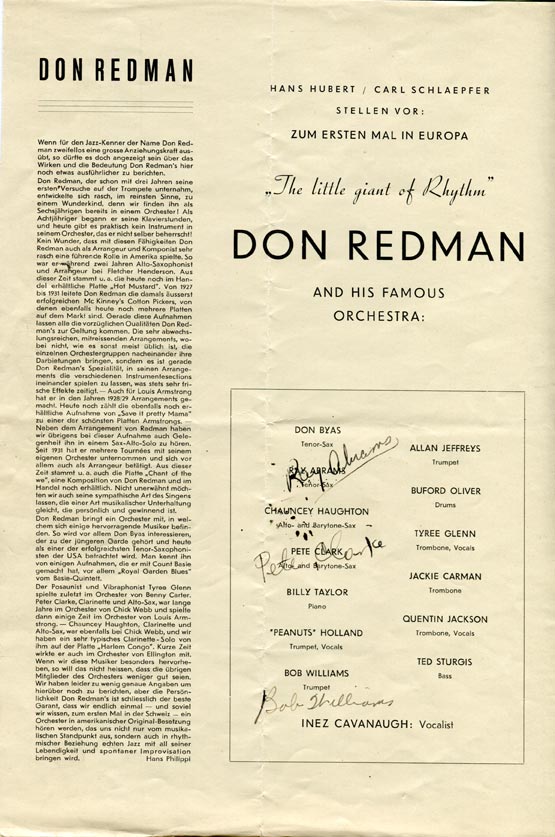 Page 2 of the program for the german speaking parts of Switzerland.
Page 2 of the program for the german speaking parts of Switzerland.
From the Otto Flückiger Collection
 Page 3 of the program for the german speaking parts of Switzerland. From the Otto Flückiger Collection. The portrait photos were taken by Helge Mass. Apart from a printer’s note page 4 of the program is blank.
Page 3 of the program for the german speaking parts of Switzerland. From the Otto Flückiger Collection. The portrait photos were taken by Helge Mass. Apart from a printer’s note page 4 of the program is blank.
The following is a translation of Hans Philippi’s promotional text (written in the language of its time) from page 2 of the swiss program. Philippi, a very important figure in Basle’s jazz life, was president of the Basel Hot Club when Redman toured Europe:
If without doubt the name Don Redman has a great attraction for those knowledgeable in jazz, it seems to be in order just the same to give a more detailed report of his works and his meaning.
Don Redman who already at the age of three started his first efforts on trumpet became very fast a wunderkind [child prodigy] in the truest sense of the word, because just six years old we already find him in an orchestra! At the age of eight he began his piano lessons and today there is practically no instrument in his band, that he is not proficient in playing! It is no wonder that with these abilities Redman was soon playing a leading role in the US also as arranger and composer. Thus for two years he was playing the alto saxophone as well as arranging for Fletcher Henderson. Amongst others the still available record “Hot Mustard” comes from this time. From 1927 to 1931 Redman led the at that time very successful Mc Kinney’s Cotton Pickers of which also there are still some records in the market. These recordings emphasize Redman’s tremendous qualities. The very diversified and rousing arrangements, in which the sections of the band do not – as is usual most of the time – bring their performances one after the other, but rather it is really Redman’s specialty to let the different sections play intertwiningly which always produces very fresh moments. He also made arrangements for Louis Armstrong in 1829/1929. Even today the still available recording of “Save It Pretty Mama” is counted among one of the most beautiful of Armstrong’s records [sic!] – Besides Redman’s arrangement we have by the way opportunity to hear him play a solo on the alto sax. Since 1931 he has also done several tours with his own orchestra and primarily also worked as arranger. From this time there’s also the record “Chant Of The We[ed]”, a composition by Redman and still available. We do not want to let his sympathetic way of singing go unmentioned, which resembles a sort of musical entertainment that is personal and appealing. Don Redman brings with him an orchestra in which there are some outstanding musicians. It is first and foremost Don Byas who will gain interest, who belongs to the younger league and is today seen as one of the most successful tenor saxophonists from the USA. He is known from some recordings he made with Count Basie, most notably “Royal Garden Blues” by the Basie Quintet. Trombone and vibraphone player Tyree Glenn last played in Benny Carter’s orchestra. Pete[r] Clarke, clarinet and alto sax, was for a few years with Chick Webb and then played for some time with Louis Armstrong’s orchestra. – Chauncey Haughton, clarinet and alto sax, also was with Chick Webb, and we have a very typical clarinet solo by him on the record “Harlem Congo”. For a short time he also worked in Ellington’s orchestra. Highlighting these musicians does not mean that the other members of the orchestra are less good. Unfortunately we do not have enough detailed information to report about this, but in the end Don Redman’s personality is the best guarantor for us to finally – and as far as we know for the first time in switzerland – hear an orchestra in the original american formation that will bring us – not only from a musical standpoint but also in relation to rhythm – real jazz with all its vitality and spontaneous improvisation. HANS PHILIPPI
The promotional photos used in Switzerland were shot in Copenhagen.

Small preview article for the german speaking part of Switzerland,
unidentified newspaper. From the Otto Flückiger Collection
From Hans Philippi’s notebooks in
the collection of Mario Schneeberger

Ad for the Bern concert, unidentified newspaper.
From the Otto Flückiger Collection
A lot of photos survive from the Bern concert.
 Don Redman in Bern. Photo by Alfred Rohrer (courtesy of www.jazzorama.ch)
Don Redman in Bern. Photo by Alfred Rohrer (courtesy of www.jazzorama.ch)
 Buford Oliver in Bern, photo by Alfred Rohrer (courtesy of www.jazzorama.ch)
Buford Oliver in Bern, photo by Alfred Rohrer (courtesy of www.jazzorama.ch)
Peanuts Holland and Bob Williams in Bern, photo by Alfred Rohrer
(courtesy of www.jazzorama.ch).
Peanuts Holland, Bob Williams and Alan Jeffreys in Bern, photo by Alfred Rohrer.
From the Otto Flückiger collection
Ray Abrams, Pete Clark, Chauncey Haughton, Don Byas in Bern, Quentin Jackson in the background, photo by Alfred Rohrer (courtesy of www.jazzorama.ch)
 Tyree Glenn and Quentin Jackson in Bern. Probably cut from a photo by
Tyree Glenn and Quentin Jackson in Bern. Probably cut from a photo by
Alfred Rohrer that originally was larger. From the Otto Flückiger collection
Review of the Bern concert, unidentified newspaper.
From the Otto Flückiger Collection
JAZZ
A concert like the appearance of Don Redman and his blacks on October 30 is not the occasion to take a firm stand in regard to the music of the american negro. Don Redman’s musicians played matter-of-factly without any pretension, their appearance is modest and respectable, their capabilities are admirable. If they just the same take part in the degeneration to which jazz has become addicted for almost ten years now – compared to the best years of Louis Armstrong, Duke Ellington, Johnny Dodds and their ilk – it is not so much themselves who are responsible for this development, but the audiences in America. Judging from the rather undiscerning applause of our jazz mad youth here in Bern, the fate of the black musicians would by the way not be much different here. Not that the applause should have been less instantaneous or even less authentic. Just the opposite, exactly this belongs to the positive side of the evening: The ability to feel enthusiam in such a way is in itself valuable – and not only a bit. But the purpose would be served much better if a clearer sense of comprehension could be felt behind all the exultation.But there were – not too mention this would be unjust – fine moments, even moments of the best kind. This happened mostly when the negroes awakened to be their own true selves – that is in regard to the accomplishments of the orchestra’s three outstanding soloists: There are those of Don Byas: Marvellous were the embellishments in the outrageous improvisation on Laura (they surely would have excited Maurice Ravel no less than Jimmy Noone’s clarinet did). Then there were the accomplishments of faun-like trumpeter Peanuts Holland (what an enthralling contrast between the delicious smile in his voice and the heroic seriousness of his golden and clear [sounding] instrument in the blues that was offered as an encore!). And finally the accomplishments of trombonist Tyree Glenn: Who would not have wished to be able to take Don’t Blame Me and Glenn’s heartwrenching lament home and the tear flowering in his tone as it sounded yesterday.
And all this follows the little cues and the witty ideas of Don Redman, the little giant of rhythm. He surely is a true psychologist, no doubt. Nothing more amiable than the times when he for example knew how to handle the insatiableness of his youthful listenership. What did Redman do? Instead of keeping on playing hot he played straight and well: as if he had touched a magic wand the excited audience cooled down at once, the applause ebbed away and the negroes had what they needed: their well-deserved repose.
Ad for the Basel concert, unidentified newspaper.
From the Otto Flückiger Collection
 Another ad for the Basel concert, unidentified newspaper.
Another ad for the Basel concert, unidentified newspaper.
From Hans Phillippi’s notebooks in the collection of Mario Schneeberger
Ticket for the Basel concert.
From Hans Philippi’s notebooks in the collection of Mario Schneeberger
Ten tracks survive from the Basel concert. According to Bruno Spoerri’s chapter “Hey! Ba-Ba-Re-Bop kontra Tiger Rag – neue Töne nach dem Zweiten Weltkrieg” in Bruno Spoerri (ed.) and others: Jazz in der Schweiz, Geschichte und Geschichten (Zürich 2005) it was Werner “Body” Buser, the clarinet player and vibraphonist from Basel, who “installed himself secretly in the cellar [of the Küchlin Theatre] with his record cutting machine.”
 Tyree Glenn in Basel, Switzerland, photo probably by Freddy Bertrand.
Tyree Glenn in Basel, Switzerland, photo probably by Freddy Bertrand.
From Hans Phillippi’s notebooks in the collection of Mario Schneeberger

The Küchlin Varieté in Basel, unknown date.
Photograph from http://www.fdb.ch
————————————————————————————-
Basel Concert
Küchlin Varieté-Theater, Basel, October 31 1946
The Don Redman Orchestra (same as before)
Embraceable You
How High The Moon (DB arr)
As Long As I Live
My Melancholy Baby (EH arr)
Oo-Ba-Ba-Le-Ba (Anthropology)
Good House (TS arr)
Stompin’ At The Savoy (DR arr, PH voc)
Stormy Weather (DR arr)
Carrie Mae Blues (DR arr, PH voc)
The World Is Waiting For The Sunrise (BT arr)
All tracks on a 2 CD set of private and/or broadcast recordings (the Basel concert was originally cut on acetates by Werner “Body” Buser) from the Otto Flückiger collection. The announcement for the unidentified Swing Riff Tune (a close relative of “Christopher Columbus”) is lost. Some sources used to note Laughin’at Life as the title for the third track, but As Long As I Live is correct.
—————————————————————————-
Autographs collected by Hans Philippi in Basel, Oct 31 1946.
From Philippi’s notebooks now in the collection of Mario Schneeberger
 Tyree Glenn, “the jungly trombonist”, as scetched by Irène Zurkinden, published in
Tyree Glenn, “the jungly trombonist”, as scetched by Irène Zurkinden, published in
an unidentified Basel newspaper. From Hans Phillippi’s notebooks in the collection of Mario Schneeberger
 Unsigned review of the Basel concert in Basler Woche, No 31, Nov. 8 1946.
Unsigned review of the Basel concert in Basler Woche, No 31, Nov. 8 1946.
From Phillippi’s notebooks now in the collection of Mario Schneeberger
The translation:
WHY JAZZ?
No, these were not our guarded Basel people anymore. This was a powerful thunderous eruptive element. The Küchlin Theatre has witnessed storms of applause before, but not to the extent as it happened when Don Redman and his 14 soloists appeared. For sure the cause for this could not be found in the purely musical area. It was the true american jazz and hot that mostly the younger generation succumbed to.
One could have a certain prejudice against jazz. One thing should be made clear though. Soloistic achievements were offered that gave witness uf unheard-of precision and high abilities. The interplay – led with seeming lightness and highest concentration by Don Redman was a disciplined and tense fabric made fit to rhythm.
We try to define the music so, that the absolute mastering of the instruments gives sound to the primeval rhythm, the inner feeling. A moan, at the same time a cheer. a shrill harmonically sounding ripping, a swelling of the sound up to the highest possible volume. Is it race, the feeling of being oppressed that shall be expressed here?
Certainly this presentation must also be assessed as art. An art of it’s own kind – nearly abstract – as it belongs to primitive peoples.
Equipped with the technical means of today they are able to present such productions for which we humans of another race might possibly not be able to bring up the necessary understanding.
From Basel the orchestra went to Zürich where they played at the Corso Palais from November 1–3. Anthony Barnett remembers visiting the late swiss jazz specialist Johnny Simmen in Zürich in the 1990s. Simmen told Barnett that the Redman concert he attended in Zürich had some difficulties. Barnett can not remember the exact details of what Simmen told him and Simmen may not have known the full reasons for the problems himself. But, whatever it was, a few of the musicians either did not turn up for the first half of the concert Simmen attended, or they walked off. One of them that Simmen certainly mentioned, according to Barnett, was Buford Oliver. Somehow everything got put right for the second half.
 Ad for the concerts in Zürich, unidentified newspaper.
Ad for the concerts in Zürich, unidentified newspaper.
From the Otto Flückiger Collection
Preview article for the Zürich concerts from Weltwoche, Nov 1 1946.
From Hans Phillippi’s notebooks in the collection of Mario Schneeberger
The translation:
MUSIC IN ZÜRICH
Jazz As Religion
The frequently reappearing phenomenon that a vanquished, subordinated, possibly inferior culture infiltrates and reforms the outwardly victorious culture, shows itself in the intrusion of negroid and asiatic elements into the music of the occident that started just when the ideal of a thoroughbred and pan-aric music seemed to fulfil itself in the will and the works of the magician of Bayreuth [i.e. Richard Wagner]. The appearance of primitive and archaic sounds – at first snobistically flavouring changed fast into an element of style appropriate to the taste of the masses. And the end of world war I with the USA’s victory brings the final triumph of jazz as the truly popular and widely understood form of music of our days, the influence on the modern concert and theatre music that has almost become “classic”.
Jazz has been praised as a cleaning reaction against the dishonest sentimentality of romanticism, as the liberator from pathos. That might have been true at the beginning. But what we, the white people, in our arrogant intelligence regard as irony and humor must not be these things for the enslaved negro, who in “plantation songs” and “negro sprituals” laments the craving of his painful, disdained existence and in euphoric ecstasy reacts against the haughtiness of his white leeches. It is really a righteous triumph of the black race, that we white people of the light – purportedly for our own recreation – dance to their tune [originally: violin] in the truest sense of the world.
For sure jazz has not only to thank its optimistic life-enhancing element for its success story but at least just as much it has to thank the painful longing and the many relations to the hereafter that are sleeping behind it like a basic melody. It is not so much the development of humankind «from pathos to irony» which makes us so receptive towards jazz but much more its opposite. The growing rationalization of every day life is awakening a growing need for «pathos», for «religio» [latin]. An old overused pathos may be scornfully cast aside, the people will quickly look for a new one, which is – at least at the beginning – more pure, better, more primitive.
The tantalizing contradiction of jazz: primitive form, fixed basic rhythm, great freedom of harmonic and rhythmic variation – unsolveable for the non negro – becomes obvious if we enter a dance hall: a swinging, vital music – and smug people sneaking about like old men, who really do not know what to do with the grandly agile inflaming music. Far from comprehending the syncopically resolved melody, the wonderfully complicated rhythmical counterpoint, feeling it with one’s body or even be able to dance to it, the appreciation and the enjoyment of Hot are limited to moving sideways like a barkeeper’s mixing cup or at the most producing a seemingly schizoid imitation of the dancing steps inherent to the negroes. Therefore there is a difference between one really being «groggy» or just pretending to be! Musicians, singers and dancers used to be one, or at least part of a community. Therefore there is an enormous difference between the exstatically inspired improvising that was typical to jazz in it’s beginnings and what disciplined-to-the-extreme jazz orchestras present as the result of most intense work.
In relation to this we would like to call attention to a small book : Von Tanz, Musik und anderen Dingen [Of Dance, Music and Other Things] by Dr. Hans M. Sutermeister.
After being dependent on records and movies for many years, it is of great interest that with Don Redman and his Negro orchestra we will finally be able to hear an american ensemble of the highest class (apperances at the Corso-Palais on November 1, 2 and 3). That will be an occasion to examine our attitude towards jazz and the way it is played in this country. P.O.S.
 “Stage only – no dancing” – ad for the saturday and the sunday concerts
“Stage only – no dancing” – ad for the saturday and the sunday concerts
in “Neue Zürcher Zeitung”, November 2 1946.
From the Otto Flückiger Collection
 Ticket for one of the Zürich concerts.
Ticket for one of the Zürich concerts.
From Hans Phillippi’s notebooks in the collection of Mario Schneeberger
Tyree Glenn at a private party in Zürich, photographer unidentified.
(courtesy of www.jazzorama.ch)
 Inez Cavanaugh at a private party in Zürich, photographer unidentified.
Inez Cavanaugh at a private party in Zürich, photographer unidentified.
(courtesy of www.jazzorama.ch)
 Tyree Glenn at a private party in Zürich, photographer unidentified.
Tyree Glenn at a private party in Zürich, photographer unidentified.
(courtesy of www.jazzorama.ch)
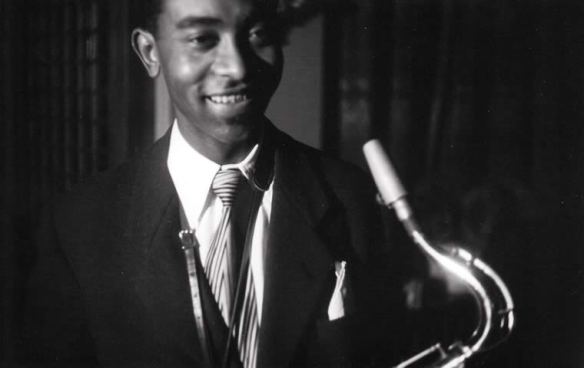 Don Byas in Zürich, photographer and venue unknown, photo possibly taken at the same private party in Zürich as the photos above. (courtesy of www.jazzorama.ch)
Don Byas in Zürich, photographer and venue unknown, photo possibly taken at the same private party in Zürich as the photos above. (courtesy of www.jazzorama.ch)
 First page of tour review in the bilingual magazine “Film, Radio Jazz” No 1, 1947 (photocopied). From the Otto Flückiger Collection
First page of tour review in the bilingual magazine “Film, Radio Jazz” No 1, 1947 (photocopied). From the Otto Flückiger Collection
 Page 2 of tour review in “Film, Radio Jazz” magazine No 1, 1947.
Page 2 of tour review in “Film, Radio Jazz” magazine No 1, 1947.
From the Otto Flückiger Collection
The following is an (unsigned) article from swiss magazine “Film, Radio Jazz”, No 1, 1947 (translated by Armin Büttner). It is not clear at which of the concerts the reviewer was present.
Don Redman leads off the guest appearances
with his jazz band
Even though Switzerland never was exaggeratedly blessed with concerts of jazz bands from America, the older swiss jazz friends had in their time opportunity to enjoy Louis Armstrong, Coleman Hawkins, Benny Carter and some others for an evening or for a longer time. The planned but unfortunately cancelled concert during the “Landi” [Swiss National Exhibition, May 6 to October 29 1939] when the war broke out was the last indication of a direct bonding between our Swiss jazz musicians and their American models. And then at the end of last year, Don Redman, the American bandleader, alto saxophonist and singer, visited us for eight days with his orchestra of 14 men. He did not bring us “garbage” as had happened in other cases. His orchestra exhibited a whole bunch of stars. Amongst others such as Don Byas from Count Basie, Tyree Glenn from Benny Carter and Cab Calloway, Herbert Holland, Chauncey Haughton from Duke Ellington, Pete Clark and Quentin Jackson participated – each of them musicians whose names every jazz fan should know. But then just the fact that Redman was coming should have been a pleasure for every jazz friend. Don Redman is a real attraction. Composer of many well-known melodies, singer with a personal touch, saxophonist with such qualities that he has to be called one of the best in the world and leader of bands that were so important in the development of jazz that you can not talk about jazz without mentioning him, as he already has led the “Chocolate Dandies”, McKinney’s Cotton Pickers” and “Don Redman’s Orchestra”, not to talk about his work in Fletcher Henderson’s Orchestra and with Louis Armstrong. Unfortunately one did not hear much from him during the last years, because the composer of a bunch of hits that are still played all the time, such as “I Heard”, “Cherry”, “How’m I Doing”, gave up his orchestra at one time and started working as arranger exclusively for the orchestras of Fred Waring, Charlie Barnet and Jimmy Dorsey. Then some day he seemed to have had enough of this activity, since he founded a new band and started out at the Club Zanzibar in New York. After this long engagement he started his European tour in relation with which we had the opportunity to finally hear real jazz again. Even though the radio and mainly the gramophone are very valuable for jazz lovers living away from the larger towns, these technical accomplishments remain only a substitute (apart from a few exceptions) and it is a pleasure not to be underestimated to hear an orchestra playing directly from the stage. And so each time one of the concerts was about to begin, a tension you could feel dominated the auditorium, a phenomenon, that could not be watched here in relation to jazz during the last years. As the tension quasi was relieved by the first sounds from the orchestra thus creating the dominating atmosphere, this atmosphere was disturbed by the whistling, hooting and stomping of certain parts of the younger generation, because – as is known – it is never a good thing when the audience becomes an active participant. In addition to that we have strong doubts here, that this overstatement of enthusiasm was consistent with the true opinions of the people we are talking about. Apart from these presentations of tastelessness the musicians received the applause they deserved. After the first bars of the concert one realized the unbelievable swing that can only be radiated by a negro orchestra. Because the rhythm section was not high-class, one has to ascribe this swing to the orchestra as a whole. Just this outstanding rhythmic momentum shows the great difference in class that exists nearly without exception between white and black orchestras. Besides that you could discover that this orchestra has a more beautiful and rounder colour of sound. Although though just the band as such was outstanding it pleased even more in its great number of distinguished soloists. Don Redman who can look back on a long successful musical career gave himself only sparse opportunities to solo. When someone asked him to play and sing more than just handing out a small sample he refused the request with the words: “I’m an old man now, you know!” After all his alto solo on “Stardust” was really enough to know that he still belongs to the highest class of them all and his vocal chorus on “Take Off Those Dark Glasses” had a swing feeling that is hardly detectable in the jazz singers of the new generation anymore. The biggest success had pianist Billy Taylor, who without doubt is among the most gifted disciples of Art Tatum. His technique does not leave a wish unfulfilled but it sometimes leads him in the wrong way, so that his solos from time to time only faintly resemble jazz and maneuver into the spheres of Ravel, Debussy and Gershwin. As accompanying pianist or as pianist in an orchestra Taylor is rather perfunctory and his playing generally not very forceful. On the other hand he has a strongly developed sense of harmonies and his melodic inventions are very beautiful most of the time and placed very fine. In short for the uninitiated he is an extraordinary pianist, but for the jazz aficionado he is not really an ideal. Another famous man in Redman’s ensemble is Don Byas, a young tenor saxophonist, who not lang ago received the «Esquire» magazine’s Silver Award. He is a pupil (not a copyist!) of the great saxophonist Hawkins. But Byas has assimilated (sic!) his master’s style very good and is baffling us with his technique and his aplomb. However he does not have much of the warmth, the largeness of sound and the strong, round tone that Coleman Hawkins calls his own. Else we find in Byas a saxophonist of great class and it is to be hoped that with time he will swap his repeated demonstrations of virtuosity for clear and logical melodic invention. The other tenor saxophonist, Ray Abrams, also made a strong impression on us. He too is a pupil of the preceding generation, a pupil of Ben Webster to be exact. (At this point we have to add that we do not want to call a musician a “pupil” who imitates his model as close as possible, we want to use the term for musicians who have assimilated (sic!) their “teacher’s” style. Abrams may have more warmth in his playing than Byas, but he sure is behind him regarding aplomb and logic. The other two saxophonists, Chauncey Houghton [sic!]and Pete Clark, usually do not emerge as soloists that much. Houghton is remarkable as a clarinetist in as much as he plays in the typical style of New Orleans; and Clarke is, although sporadically, an agreeable solist on alto saxophone and clarinet. Standing out among the trumpeters is Herbert Lee “Peanuts” Holland, who, inspite of his undeniable qualities, has not found a style of his own yet, from time to time he plays solos in the most unsympathetic “modern” way, sending out from his horn as many notes as possible in the shortest time. Then you can not talk about melody and swing anymore. Else he plays calm, steady and majestically in a way you usually only get it from the terrific Louis Armstrong. But naturally in no way does Holland reach Armstrong’s greatness, since his improvisations are only inspired for short periods of time. “Peanuts” also sings with nice intonation and lots of swing. We heard the other trumpets, Alan Jeffries (sic!) and Bob Williams, only sporadically, so we could not get an exact picture of their abilities. Let it just be said, that Jeffries belongs to the new school of jazz while William’s school is of the true variety. The team of trombone players was completely outstanding regarding tone as well as regarding swing and phrasing. Something like this has never been heard in Switzerland before! Two of the three trombonists must belong to the best specialists for this instrument. These are “Fats” Tyree Glenn and veteran Quentin Jackson. Glenn pleases right away with his inner and outer calmness, his beautiful and logical melodic inventions and his full round sound. We surely can predict a great career in music for Glenn, he has everything that is needed for it: originality, swing, tone, ideas, musicality and everything else. From time to time we find the influence of the great Dickie Wells in his playing, but aside from that Tyree Glenn is now an already very personal player – this truly represents a rarity if you look at the status quo in jazz music today. We had the opportunity to listen to Glenn play on a private occasion after the concert and he appeared in an even better light than during the concert. Also on the vibraphone he does great things, above all regarding his timing. Quentin Jackson mainly impresses with his round, and at the same time biting (though not blaring) sound. Jackson too showed that he is able to improvise beautiful solos, although his inspiration was not on the same high level as Glenn’s and his aplomb in execution sometimes leaves a lot to be desired. Jackie Carman, the third trombonist and only white member of the orchestra, was not that convincing as soloist, but blends in very well with the trombone team. Drummer Buford Oliver – although he does not belong to the class of greats – has to be lauded for his discreet and very intelligent support, and bassist Ted Sturgis made good in roundness of tone and good phrasing during his solos for what he lacked in swing and force. Inez Cavanaugh sang with the band, she has an interesting voice, but does not sing very convincingly. All in all the following has to be said about Don Redman’s concerts in this country: From a European standpoint these concerts were true events, and from this point of view almost everything would have to be lauded, and nearly nothing to be criticized. Compared to the present state of today’s jazz music, one can see that the orchestra may have a respectable number of good – and even outstanding – soloists and that the brass section has to be valued high regarding quality, but that the sax team and the rhythm section are rather tepid, which of course is hurting the great picture. For the lover of jazz, who, regarding the possibility of direct audition, was only exposed to the sentimental or loud and swingless emissions of local production, Don Redman’s tour was a real feast.
The following is a review (written in very long and complicated sentences and unfortunately unsigned) of one of the Zürich concerts. Again it is not clear on which day the reviewer saw the band – probably on November 1 or November 2.

Review of the Zürich concerts, in Neue Zürcher Zeitung Nov 4, 1946.
From Hans Phillippi’s notebooks in the collection of Mario Schneeberger.
An attempt at translation:
Negro Jazz at “Corso-Palais”
Nearly nowhere does Hans von Bülow’s sentence «At the beginning there was Rhythm” get a more vital meaning than with the negroes, especially with the negroes from the bushes of africa put into a frantic trance by palm wine, eros and age-old rites. Compared to these the eleven north-american “colored gentleman” which Don Redman has gathered around him (three from his troupe are white, they have to leave the musical superiority to their brown-black comrades though) were elegant civilized people who own immaculate trousers and glasses, bow before the audience after every solo performance and in their jazz – from which only a narrow bridge is still leading to the soulful music of the plantation negro in the southern states – in no way deny the age of the pounding machines and the humming dynamo.
The power to attract this jazz has is mostly grounded in its optimistic, very here-and-now joy-of-life and in the rhythmic tension, it gets from his syncopated notes and its rhythmical “breaks”, furthermore in its close connection to dancing, which belongs to the first arts of mankind. Don Redman’s team of musicians, which in its solistic loosening-ups [it is hard to translate this sentence close] is without doubt more interesting as regarding their ensemble play, completely abstains from string instruments and mostly on reeds too. Only the clarinet is used from time to time. Noticeable is also the disdaining of plucked instruments (guitar, banjo and so on). The characteristical color thus is primarily evolving from the blowing instruments: The “gemütliche” [a very special german word, the best translation of which seems to be “unhurried”] trombone player Tyree Glenn, the jolly trumpeter and vocalist Peanuts Holland, who during the first showing on friday excelled in the improvisation over “Hey-Ba-Ba-Re-Ba”. tenor player Ray Abrams, Chauncey Haughton who proved himself to be a virtuoso clarinet player and the young modest tenor saxophonist Don Byas from whom stems a part of the arrangements. At the drums with a happy temperament Buford Oliver is sitting, whereas Ted Sturgis who appears like a pretty relative of Gandhi is the dreamy poet on the stand-up bass. While reeds and brass are shining in neck-breaking glissandi and real hot vibrato, Billy Taylor at the grand piano shows with tender imitations of bells and harps that he is a master of paraphrasing and of the wildest runs. Whatever he plays: “All The Things You Are”, “The World Is Waiting For The Sunrise” or any other solo, has that amazing technique of the art of improvisation and variation, that belongs to the basic element of Hot-Jazz. Not always able to convince was singer Inez Cavanaugh, who, though owning a good “piano” is executing some negro spirituals in a not very original and spirited way [no pun here in the german language].
Pudgy Don Redman is without a doubt a many-sided connoisseur of jazz. He himself plays the alto saxophone and sings (unfortunately only too rarely) his charming specialty, humorous children’s songs. But he is a talented and renowned arranger, esteemed my masters of jazz like Louis Armstrong, who maybe does not have Ray Ventura’s refinement inspired by western classical music, but writes effective parts for his soloists. Some of his arrangements, of “Stormy Weather” (with a sonorous trio of trombones), of “Metronome All Out” (Duke Ellington) and “For Europeans Only” (Tad (sic!) Dameron) may be over ten years old, but still are fascinating. Several times during the extended program which was enriched by many applauded encores – his first three day engagement in Zurich ended sunday evening – he was noticed as a composer enthused by Hot, in which in most cases the variations over a basic melody proved to be more inventive than this melody itself.
 Don Redman’s autograph collected at an unknown venue in Switzerland.
Don Redman’s autograph collected at an unknown venue in Switzerland.
From the Otto Flückiger Collection
Swiss jazz researcher Kurt Mohr witnessed eight concerts by the Redman orchestra, probably all in switzerland. In an article more than six pages long in “Hot-Revue”, 2nd series No. 12/1946 , he added more information about the musicians and adds impressions from the concerts (click on pictures to enlarge):
 (Click to enlarge: Article by Kurt Mohr in swiss “Hot-Revue” No. 12/1946.
(Click to enlarge: Article by Kurt Mohr in swiss “Hot-Revue” No. 12/1946.
From the Otto Flückiger Collection
Mohr notes that “Tyree Glenn, who possibly is not appreciated enough as trombonist, is a great show man at the vibraphone.” He mentions nice trombone solos by Glenn in Embraceable You, Don’t Blame Me and Star Dust. Mohr calls Glenn a “first class trombone player with great technique”. Quentin Jackson, says Mohr, played in the style of Dickie Wells in the few solos he took. About Buford Oliver Mohr writes that he made a great impression inspite of his broken leg.
One one of the last pages of “Hot-Revue” No. 12/1946 there is an added photo of Inez Cavanaugh:
Inez Cavanaugh on a photograph published in “Hot-Revue” No, 12/1946.
From the Otto Flückiger Collection
In early November the orchestra started a short tour for the US Army in Germany. A scheduled four-week tour in England supposed to be managed by Jack Hylton “and maybe Paris afterwards” (Gurwitch, see above) was cancelled, because the English musician’s union wouldn’t allow it. It wanted to retaliate for the AFM ban placed on British musicians seeking engagements in the US (“Redman Ej till England,” Orkester Journalen, December 1946, 8. “British Retaliates by Barring Don Redman”, Afro-American, November 16 1946, 8. “Redman nekad Englandsbesök”, Estrad, December 1946).
 Afro-American, November 16 1946, 8
Afro-American, November 16 1946, 8
Article from Estrad, December 1946.
Courtesy of Stephan Veil
Reader’s letter describing a concert in Heidelberg in Orkester Journalen No 12/1946.
Courtesy of Stephan Veil
Here is the translation, supplied by Leif Bo Petersen:
Don Redman in Heidelberg
Redman’s tour through the American occupation zone in Southern Germany was mirrored in the AFN-programs in October. Thus he played at the “Star Dust Club” in Heidelberg at the 8th, and AFN Frankfurt carefully spread the event. Don and his men seemed to be in good shape in spite of the tiring traveling and seemingly played with considerably more spirit and precision than in Stockholm. Maybe the audience also was more enthusiastic than the one in Koncerthuset. Asked of his opinion of the European tour Don uttered with conviction: “Killer-dilling.”
The repertoire was not exact the same as in the Stockholm concerts. For sure “For Europeans Only” and Tyree Glenn’s vibraphone-solo ”Melancholy Baby,” had the same execution as here, but besides this the orchestra played “Stormy Weather” with an orchestra vocal and Leap Frog, where Peanuts Holland and Ray Abrahamson were featured. Byas’ solo number was “These Foolish Things,” Inez Cavanaugh sang “Prisoner of Love,” and Don’s own hoarse voice was heard in “Baby, You’re the One for Me.” To a high degree the microphone allocation (where Swedish radio has a lot to learn) contributed to the good impression that the band made.
Ken.
According to famous czech pianist and composer Emil Viklický we know (via Doug Ramsey’s Rifftides) that Jan Hammer, Sr. – father of the famous keyboarder and film composer Jan Hammer Jr. – and other members of the Kamil Behounek big band from Prague heard the Redman band in Nuernberg, Apparently, the American and Czech bands appeared opposite one another and the musicians interacted. Soon, Hammer and others formed a bebop quintet that played regularly in Prague’s Café Pygmalion.
Emil Viklický – who in 1971 played with Ludvik Svab in Ludek Hulan’s band, has more to say on the influence Redman’s band had on young czechoslovakian boppers (email to Doug Ramsey July 2011):
Le magazine JAZZ – published by Emanuel Uggé – was printed for two years, from 1947-48. In the May 1947 issue there is detailed description of be-bop, with printed music examples – transcriptions of Dizzy´s licks. It was written by Lubomir Doruzka and Dr .Ludvik Svab. Mr. Doruzka was theoretician, but Svab was an active musician – a guitarist – and he was a member of the Behounek band, that had visited Nuernberg.
The last german concert of Don Redman’s orchestra took place at the Munich Club in Munich (“Redman Due Back,” Variety, November 30, 1946, 11). After that the orchestra dissolved.
Jack Carman and Alan Jeffreys signed with the Special Services for playing in Germany. Don Redman, Don Byas, Billy Taylor, Chancey Haughton, Tyree Glenn, and Inez Cavanaugh stayed in Paris having signed a 3-months nightclub engagement.
Most discographies show a six track session for the company Swing by members of the orchestra in Paris as early as October 18 1946, which can not possibly be. The only sources that have the date right for this session are The New Hot Discography by Charles Delaunay (1948), the Don Byas discography/solography by Salemann & Vogler (1992) and the discography accompanying the french CD Chrono(lo)gical Classics 1009, Don Byas 1946, which was probably compiled by Kurt Mohr.
———————————————————————————-
 Courtesy of Little Beat Records
Courtesy of Little Beat Records
 Courtesy of Little Beat Records
Courtesy of Little Beat Records
 Courtesy of Little Beat Records
Courtesy of Little Beat Records
 Courtesy of Little Beat Records
Courtesy of Little Beat Records
Billy Taylor (435, 436) / Tyree Glenn & his Orchestra (437) / Don Byas and his Orchestra (438, 440) / Peanuts Holland and his Orchestra (439)
Paris, December 4 1946.
Peanuts Holland-1 (tp, voc), Tyree Glenn-1 (tb, vib, voc), Hubert Rostaing-1 (cl), Don Byas-1 (ts, arr), Billy Taylor (p), Ted Sturgis-2 (b), Buford Oliver-2 (dr)
(OSW-435) The Very Thought Of You Swing 234A
(OSW-436) Stridin’ Down Champs-Elysees-2 Swing 234B
(OSW-437-1) Working Eyes-1, 2 Swing 232B
(OSW-438-1) Gloria-1, 2 Swing 232A
(OSW-439-1) Peanut Butter Blues-1, 2 Swing 235
(OSW-440-1) The Mohawk Special Swing 235A
 Courtesy of Little Beat Records
Courtesy of Little Beat Records
 Courtesy of Little Beat Records
Courtesy of Little Beat Records
———————————————————————————–
According to an unsigned article in Jazz Hot, Noël 1946, the orchestra spent the afternoon of December 4th at the headquarters of the Hot Club de France in Rue Chaptal. 
Unsigned article from Jazz Hot, Noël 1946 (this is the “Noël” (Christmas) issue. It should have been numbered “11” but erroneously carries “12” on the cover.
This error was duly noted in the real Jazz Hot, No. 12.) The blackened part of the scan is not related to Redman.
A PART OF THE BAND GOES HOME
On December 7, Ray Abrams, Pete Clark, Bob Williams, Quentin Jackson and Ted Sturgis leave from Southhampton England on board the Queen Elisabeth. (A. Gurwitch, “Jazz Returns to Europe,” Metronome, February 1946, 29). Though Buford Oliver is not mentioned under the remainingin Gurwitch’s article, he stayed for a while as he was still with the band at their mid and late december concerts in Paris.
The above article from the “Noël” issue of Jazz Hot mentions a recent concert at Salle Pleyel on December 15 (the band played there also on December 22, see program flyer below) as well as an upcoming engagement at the Beaulieu. “Le Beaulieu” was at 168 rue du Faubourg Saint-Honoré. According to Jean Rousseau, Lieux Parisens du Jazz, Répertoire Historique, in Les Cahiers du Jazz, Nr. 1 (January 2001), 207-215, it presented jazz from 1942 to 1947.
Flyer for the Don Redman et ses Solistes concert at Salle Pleyel, Paris.
With photographs by Helge Mass.
Picture taken from an ebay-auction
The reduced orchestra at the Pleyel concerts consisted of Peanuts Holland (tp, voc), Tyree Glenn (tb), Don Redman (as, voc), Don Byas (ts), Billy Taylor (p), Jean Bouchetty (b), Buford Oliver (dr). Also in December the Redman orchestra entered into a contract at Beaulieu with the following line-up: Peanuts Holland (tp, voc), Nat Peck, Tyree Glenn (tb), Don Redman (as, voc), Don Byas (ts), Billy Taylor (p), J.J. Tilché (g), Jean Bouchetty (b), Buford Oliver (dr), Inez Cavanaugh (voc). (A. Hodeir, “Don Redman à Pleyal,” Jazz Hot, 1946, 2nd series, no. 12, 6–7. G. Montassut, “Redman au Beaulieu,” Jazz Hot, 1946, 2nd series, no. 12, 7–8).
On December 22 Don Redman et ses Solistes played a concert at the Salle Pleyel in Paris.
The program for this event shows photos of Redman, Holland and Byas. From Andrè Hodeir’s review of the concert in “Jazz Hot” (second series, No. 12, published in January 1947), we know that Glenn, Taylor and Oliver were also there. The bass player for this event was Jean Bouchety, the bass player from Alix Combelle’s band. The same issue also has a review by Guy Montassut, who witnessed a later concert at the Beaulieu in Paris. The article has some statements by Redman, Byas, Holland, and Glenn. There is also a short statement by trombonist Nat Peck who played with the band at least at the Beaulieu. From Montassut’s article we also learn, that Bouchety was at the Beaulieu as well, and that J.J. Tilché had been added on guitar.
 (Click to enlarge) Concert Reviews in “Jazz Hot” (2nd series, No. 12, January 1947).
(Click to enlarge) Concert Reviews in “Jazz Hot” (2nd series, No. 12, January 1947).
From the collection of Otto Flückiger
In the December 28 1946 issue, Billboard again had an eye on what Redman’s men were doing:
After part of the Orchestra had left France, some of its remaining members were invited to record for the two most important french jazz record companies, Swing and Blue Star.
———————————————————————————–
———————————————————————————–
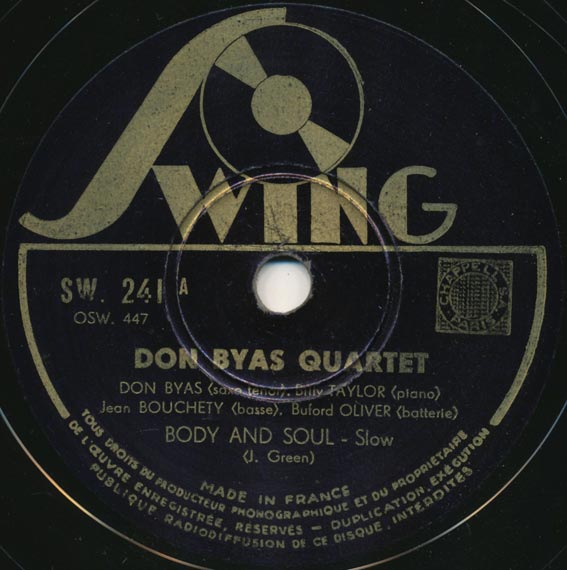 Courtesy of Little Beat Records
Courtesy of Little Beat Records
Courtesy of Little Beat Records
Don Byas Quartet
Paris, January 6 1947.
Don Byas (ts, arr), Billy Taylor (p), Jean-Paul Bouchety (b), Buford Oliver (dr)
(OSW-444-1) I’m Beginning To See The Light Swing 241
(OSW-445-2) Rosetta Swing 269
(OSW-446-1) Ain’t Misbehavin’ Swing 267
(OSW-447-1) Body And Soul Swing 241
(OSW-448-2) Blue And Sentimental Swing 267
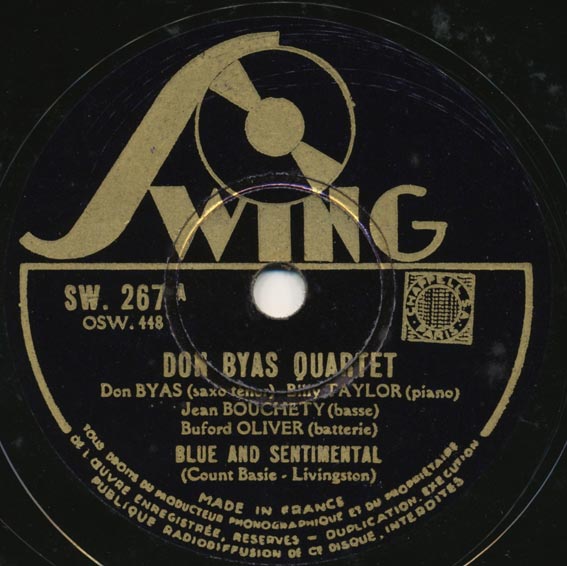 Courtesy of Little Beat Records
Courtesy of Little Beat Records
Courtesy of Little Beat Records
———————————————————————————-
Courtesy of of Little Beat Records
Courtesy of Little Beat Records
Paris, January 13 1947.
Peanuts Holland-1 (tp), Tyree Glenn (tb), Hubert Rostaing-2 (as), Don Byas (ts), Billy Taylor (p), Jean-Jacques Tilché (b), Buford Oliver (dr)
(ST-1869) Mad Monk-1, 2 Blue Star 24B
(ST-1870) Please Don’t Talk About Me When I’m Gone-1, 2 Blue Star 26B
(ST-1871) The Hour Of Parting-1, 2 Blue Star 25B
(ST-1872) I Can’t Get Started-2 Blue Star 26A
(ST-1873) Billies Bounce (sic!)-1, 2 Blue Star 24A
(ST-1874) I Surrender Dear Blue Star 25A
From the collection of Armin Büttner
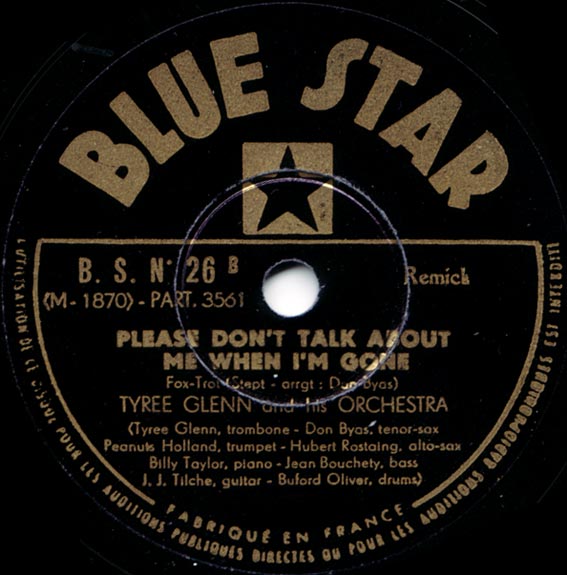 From the collection of Armin Büttner
From the collection of Armin Büttner
———————————————————————————–
Courtesy of Little Beat Records
Courtesy of Little Beat Records
Don Byas Ree-Boppers / Don Byas (1899) / Don Byas and his Orchestra (1899)
Paris, January 27 1947. Peanuts Holland (tp, voc-1), Tyree Glenn (tb), Don Byas (ts), Billy Taylor (p), Jean-Jacques Tilché (g), Jean Bouchety (b), Buford Oliver (dr)
(ST-1895) Walking Around Blue Star 28B
(ST-1896) How High’s The Moon (sic!) Blue Star 29A
(ST-1897) Red Cross Blue Star 28A
(ST-1898) Laura Blue Star 27
(ST-1899) Cement Mixer-1 Blue Star 27B
(ST-1900) Dynamo A Blue Star 29B
———————————————————————————–
Courtesy of Little Beat Records
————————————————————————
A short note in Jazz Hot, No. 13 (February 1947) says that the band – but without Redman – was in Holland for a week where the band’s engagement at the “Parkzicht” in Rotterdam was terminated abruptly –but we are not told the reasons.
Short note from Jazz Hot No. 13 (2nd series), February 1947.
The solists of Don Redman, without the latter, made a tour in Holland. Under the direction of trombonist Tyree Glenn they have played at the «Parkzicht». But the contract was broken in a rather brutal manner by the director of the club and the orchestra got stranded. The musicians profited their from stay in recording four sides for Decca and made radio broadcasts.
The band with added trombone player Nat Peck also made broadcasts for a dutch radio station which might still exist. And they also recorded four sides for the dutch arm of Decca.
———————————————————————————–
 From the collection of Mario Schneeberger
From the collection of Mario Schneeberger
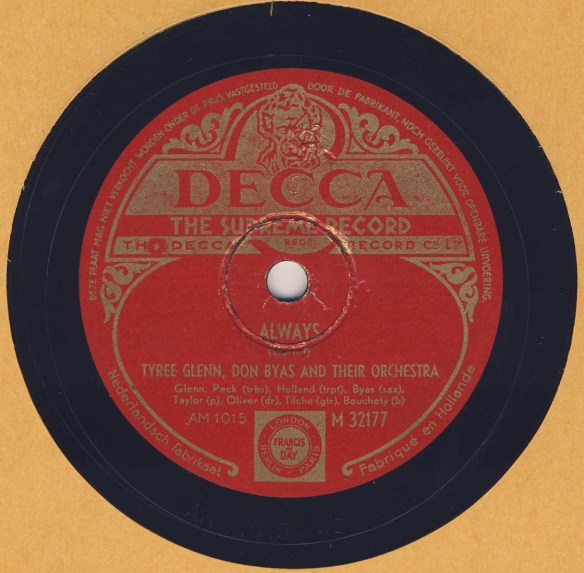 From the collection of Mario Schneeberger
From the collection of Mario Schneeberger
Tyree Glenn, Don Byas and their Orchestra
Peanuts Holland (tp), Tyree Glenn (tb, vib-1), Nat Peck ( tb), Don Byas (ts), Billy Taylor (p), Jean-Jacques Tilché (g), Jean Bouchety (b), Buford Oliver (dr)
Holland, February 17 1947.
(AM1014-B) Humoresque Decca (NL) M-32177
(AM1015-4B) Always Decca (NL) M-32177
(AM 1032-A) Poor Butterfly Decca (NL) M-32178
(AM 1033-1) My Melancholy Baby-1 Decca (NL) M-32178
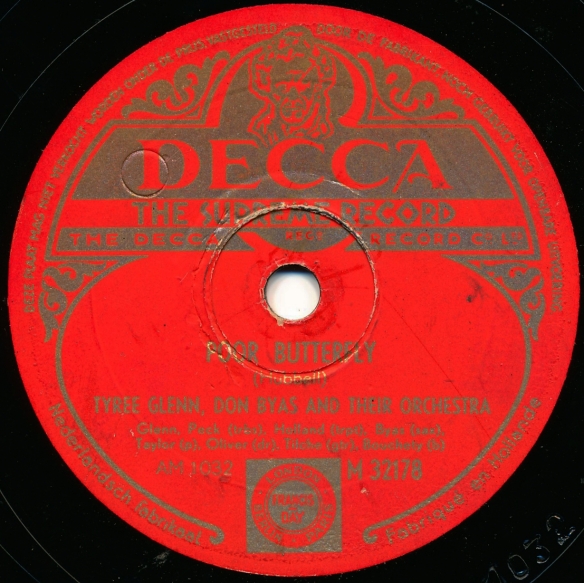 Courtesy of Little Beat Records
Courtesy of Little Beat Records
Courtesy of Little Beat Records
———————————————————————————
Tyree Glenn reurned to Sweden and stayed there for a while. This had already been announced in the December issue of Estrad.
Small note from Estrad, December 1946.
Courtesy of Stephan Veil
———————————————————————————
 Courtesy of Little Beat Records
Courtesy of Little Beat Records
Courtesy of Little Beat Records
Tyree Glenn med Simon Brehms Kvintett
Tyree Glenn (tb, vib), Åke Hasselgård (cl), Thore Swanerud (p), Sten Carlberg (g), Simon Brehm (b), Bertil Frylmark (dr).
Stockholm, March 28, 1947
114-E My Melancholy Baby Musica (SE) A9203
115-C Sweet Lorraine Musica (SE) A9203
Both tracks are also on Golden Era of Swedish Jazz (Tels TR11009) and Stan Hasselgard Cotton Top 1946-49 (Drag DRCD 332). Sweet Lorraine also appears on The permanent Hasselgard (Phont PHONTNCD8802).
———————————————————————————
 Courtesy of Little Beat Records
Courtesy of Little Beat Records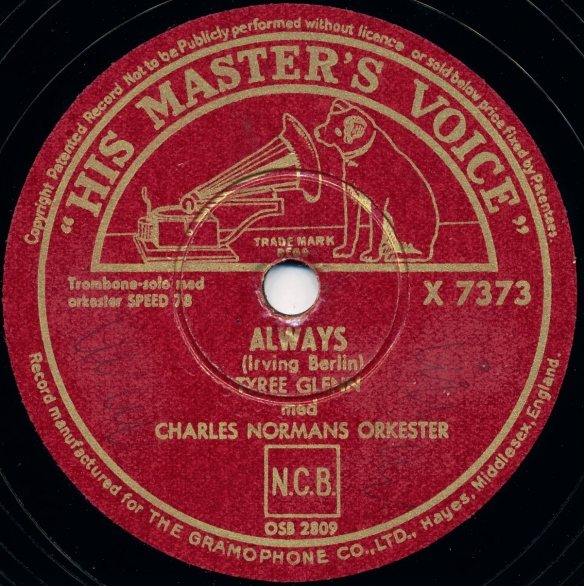
Courtesy of Little Beat Records
Tyree Glenn med Charles Norman Trio
Tyree Glenn (tb vib), Charlie Norman (p), Simon Brehm (b), Anders Burman (dr).
Stockholm, April 1, 1947
2808-1 Limehouse Blues HMV X7373
2809-2 Always HMV X7373
———————————————————————–
We learn from America that trombone player Tyree Glenn has entered into Duke Ellingtons orchestra after a stay in Sweden that lasted some months . «Peanuts» Holland is still in the country while Don Byas – after having played in Belgium, just in Brussels, soon in Liège, has been engaged … by Bernard Hilda!
As for Redman, staying put in Paris, he is arranging for the orchestra of Alix Combelle!
No comment.
At some time in 1947 Allan Jeffreys and Jack Carman went to Paris, where they took part in what is often called the “first french be bop session” under the leaderships of alto saxophonists Robert Mavounzy and Hubert Fol.
———————————
The first issue of “Swingin’ In Lutetia”. From the collection of Armin Büttner
From the collection of Armin Büttner
Courtesy of Little Beat Records
Courtesy of Little Beat Records
Robert Mavounzy Be-Bopers [sic] [464-467] / Be Bop Minstrels [468-470]
Allan Jeffreys (tp), Jack Carman (tb), Robert Mavounzy (as-1), Hubert Fol (as-2), André Persiany (p), Emmanuel Soudieux (b), Benny Bennett (dr)
Paris, July 4 1947
OSW-464-1 John Payne Was Here-1 (Carman) Swing SW261
OSW-465-1 Sèvres-Babylone-1 Swing SW265
OSW-466-1 Sweet And Bebop-1 (Jeffreys) Swing SW265
OSW-467-1 These Foolish Things-1 Swing SW 261
OSW 468-1 A Night In Tunisia-2 Swing SW260
OSW-469-1 Swingin’ In Lutetia (Lubie Loo*)-2 Swing SW260, SW269*
OSW-470 Lubie Loo (Carman)-2 Emi/Jazz Time 251288-2 (CD)
Note: John Payne Was Here and These Foolish Things were reissued on Jazz-Time 781336-2 (CD), a compilation of tracks by Robert Mavounzy. We used to think that Jack Carman’s composition really should be titled Tom Paine Was Here, since we thought it was named for Tom Paine 1736/1737–1809, who assisted in the french revolution and in the process that led to to american independance. But one of Jack’s brothers confirmed via Patrick Dorian that “John Payne” was almost certainly correct and referred to the Hollywood actor of that name active in Jack’s early days.
What’s more, in January 2012 Pierre Fargeton was so nice as to supply the sheet music for John Payne Was Here:
 Courtesy of Pierre Fargeton. Claude Lawrence is pseudonym for André Hodeir.
Courtesy of Pierre Fargeton. Claude Lawrence is pseudonym for André Hodeir.
(click to enlarge)
Regardless of what other discographies say, OSW-469 (“Swingin’ In Lutetia”) was correctly titled on Swing 260. It was incorrectly issued as “Lubie Loo” on Swing 269 (see review sections in Jazz Hot, Nos. 18, 19, 21, 22, 1947). The real “Lubie Loo” was released many years later on an EMI CD.
 What is called “Lubie Loo” on the label of Swing SW 269 A
What is called “Lubie Loo” on the label of Swing SW 269 A
really is matrix number 469-1, “Swingin’ In Lutetia”
From the Otto Flückiger collection
Allan Jeffreys (tp), Jack Carman (tb), Hubert Fol (as-2), André Persiany (p), Stanislas Czabanick (b), Robert Mavounzy (dr) same session
OSW 468-2 A Night In Tunisia Swing unissued
OSW-471 Makin’ Bebop Emi/Jazztime 780373-2 (CD)
———————————————–
Jack Carmen and Allan Jeffries
on a photograph by “Marchal”,
probably taken at the July 4 session.
 Hubert Fol on a photograph by “Marchal”,
Hubert Fol on a photograph by “Marchal”,
probably takenat the July 4 session.
The two photos above were originally
accompanying a review of Swing 260
and Swing 261 in “Jazz Hot” No. 18, 1947.

Robert Mavounzy, photo taken from a Selmer ad in
Jazz Hot (No. 4, January–February 1946)
 Stanislas Czabanick
Stanislas Czabanick
pictured in Jazz Hot No. 19, 1947
Via Patrick Dorian – who was taught by Jackie Carman – the Carman family has supplied a biographical sketch of Carman’s professional life (the original was handwritten by Jackie Carman at an unknown date, Carman passed in 2005).
1941 Began trombone lessons with William LaVac. Played in band and orchestra at Freeport High School, NY.
1943 Played in Sid Harris’s big band at Wheatley Hills Tavern in Westbury, NY and then at San Su San in Mineola, NY. Joined Local 802, Associated Musicians of Greater NY. Played with the orchestra of Harry Hardin at the Town Barn in Buffalo, NY.
1944 I joined Boyd Raeburn’s Band in New York City. I played with this organization almost two years. We did five recording dates and several transcription dates during that time.
1946 I went on tour with Georgie Auld’s Band. I recorded with Georgie in NYC. Sarah Vaughan sang on “You’re Blase.” In September 1946, I auditioned for Don Redman’s Band. We were the first American jazz band to tour Europe after WWII. We played jazz concerts in Denmark, Norway, Sweden, Belgium, Switzerland and Germany. There were many notable musicians in this band.
1947 After Don Redman’s tour, the trumpet player Alan Jeffreys and myself played in an orchestra at the “Stardust Club” in Heidelberg, Germany. Following this we went to Paris, France on vacation. While there we were both made honorary members of “The Hot Club of France.” We also made a recording date with four French jazz musicians.
1948 I played most of this year with Buddy Rich’s big band. We made a half hour musical short at Universal Studios in Hollywood, while appearing at the Palladium Ballroom. We also played a long theatre tour.
1952 In January, I was drafted into the United States Marine Corp. I went to Korea, where I was selected to lead the 1st Marine Division Jazz and Show Band. I was promoted to the rank of Sergeant. I toured theatres with Clyde McCoy’s band and the singer Patti Paige.
Other bands I have played in include: Jimmy Palmer, Nite Caps, Delaware Symphony (while I was a student at West Chester State College), Victor Lombardo, Roy Stevens, Lee Castle, Red Ingle and his Natural Seven, Clem DeRosa, Georgie Auld’s nine piece group, and I’m on a CD by Rod Raephael.
I received a Bachelor of Science Degree in Music Education from West Chester State Teachers College on January 31, 1960. I then taught vocal music for a half year in the Tredyffrin/Easttown School District in Pennsylvania.
In September 1960, I started teaching in the South Huntington Schools where I worked for twenty four years before retiring. I received my Master of Arts Degree from Columbia University on December 16, 1964. While teaching at Countrywood Elementary School, I was selected as teacher of year by Bob Bird, the principal. My wife and I also received a proclamation from Suffolk County Supervisor Peter Cohalin, recognizing both of our achievements in public school education.
At the present time I perform with Rod Raephael’s twenty one piece band, Tony Terranova’s seven piece “Little Big Band” and a nine piece group called “Retro.” I also do subs for Dixieland, Jazz, and commercial bands. I’ve played with The Nassau County Police Blue Lion’s Band for more than five years.
It was also probably in connection with the July 4 session, that Jazz Hot talked to Carman and Jeffries, the interview leading to a two-part article “En Parlant (Un Peu) De Bebop” in Nos. 17 and 18, 1947.
(Click to enlarge) From Jazz Hot No. 17 1948. Otto Flückiger Collection
(Click to enlarge) From Jazz Hot No. 18 1948. Otto Flückiger Collection




